Gray Brick Wall Surface Damage Detection of Traditional Chinese Buildings in Macau: Damage Quantification and Thermodynamic Analysis Method via YOLOv8 Technology
Abstract
Featured Application
Abstract
1. Introduction
2. Literature Review
2.1. Damages of Traditional Gray Brick Buildings
2.2. Identification of Damage to Traditional Chinese Buildings
2.3. Development of Equipment for Identifying Surface Damage
3. Materials and Methods
3.1. Research Process
3.1.1. Data Collection Stage
3.1.2. Data Processing Stage
3.1.3. Data Annotation Stage
3.1.4. Model Training Stage
3.1.5. Model Testing Stage
3.1.6. Model Application Stage
3.2. YOLOv8 Model Structure
4. Results
4.1. Model Training Results
4.2. Model Testing
4.3. Comparison with YOLOv12
5. Discussion
5.1. Model Application
5.2. Development of Intelligent Identification Devices
5.3. Limitations
6. Conclusions
7. Patents
Supplementary Materials
Author Contributions
Funding
Institutional Review Board Statement
Informed Consent Statement
Data Availability Statement
Acknowledgments
Conflicts of Interest
Appendix A. YOLOv12 Results
| Epoch | Time | Train/Box_Loss | Train/Cls_Loss | Train/Dfl_Loss | Metrics/Precision (B) | Metrics/Recall (B) | Metrics/mAP50 (B) | Metrics/mAP50-95 (B) | Val/Box_Loss | Val/Cls_Loss | Val/dfl_Loss | lr/pg0 | lr/pg1 | lr/pg2 |
|---|---|---|---|---|---|---|---|---|---|---|---|---|---|---|
| 1 | 21.1331 | 1.13228 | 2.58449 | 1.42763 | 0.36953 | 0.40637 | 0.17634 | 0.12942 | 0.78249 | 1.67911 | 1.13701 | 0.003311 | 0.003311 | 0.003311 |
| 2 | 41.5274 | 0.91626 | 1.68037 | 1.24703 | 0.372 | 0.39525 | 0.27086 | 0.20327 | 0.79708 | 1.68655 | 1.10559 | 0.006644 | 0.006644 | 0.006644 |
| 3 | 60.9578 | 0.92176 | 1.73694 | 1.22611 | 0.37503 | 0.40158 | 0.28426 | 0.19314 | 0.97998 | 2.26934 | 1.22532 | 0.009977 | 0.009977 | 0.009977 |
| 4 | 80.9316 | 1.15363 | 1.82359 | 1.32235 | 0.35755 | 0.46769 | 0.31725 | 0.22491 | 0.98621 | 2.19856 | 1.22741 | 0.009998 | 0.009998 | 0.009998 |
| 5 | 101.092 | 0.98677 | 1.72431 | 1.25079 | 0.3022 | 0.61785 | 0.38608 | 0.28144 | 0.88991 | 1.57992 | 1.13808 | 0.009996 | 0.009996 | 0.009996 |
| 6 | 121.219 | 1.01499 | 1.53932 | 1.23355 | 0.49548 | 0.44133 | 0.40702 | 0.30693 | 0.87161 | 1.42847 | 1.11923 | 0.009993 | 0.009993 | 0.009993 |
| 7 | 141.193 | 0.98405 | 1.46314 | 1.20054 | 0.67831 | 0.42434 | 0.42656 | 0.31925 | 0.8255 | 1.3017 | 1.08336 | 0.00999 | 0.00999 | 0.00999 |
| 8 | 161.013 | 0.91548 | 1.47248 | 1.19068 | 0.41633 | 0.47558 | 0.38347 | 0.2837 | 0.87832 | 1.66284 | 1.12915 | 0.009987 | 0.009987 | 0.009987 |
| 9 | 180.621 | 0.94087 | 1.37844 | 1.17429 | 0.42804 | 0.51747 | 0.40847 | 0.29544 | 0.89743 | 1.38546 | 1.13334 | 0.009982 | 0.009982 | 0.009982 |
| 10 | 200.626 | 0.90222 | 1.33854 | 1.17332 | 0.38765 | 0.55594 | 0.50196 | 0.37304 | 0.84153 | 1.31147 | 1.15113 | 0.009978 | 0.009978 | 0.009978 |
| 11 | 220.671 | 0.92004 | 1.30938 | 1.20296 | 0.52856 | 0.51334 | 0.46529 | 0.35658 | 0.81724 | 1.24658 | 1.12401 | 0.009973 | 0.009973 | 0.009973 |
| 12 | 240.627 | 0.87954 | 1.34846 | 1.17202 | 0.52562 | 0.52111 | 0.4911 | 0.33756 | 1.01436 | 1.26276 | 1.20233 | 0.009967 | 0.009967 | 0.009967 |
| 13 | 260.696 | 0.93724 | 1.31193 | 1.21084 | 0.51214 | 0.56976 | 0.46642 | 0.34708 | 0.86812 | 1.31014 | 1.13479 | 0.009961 | 0.009961 | 0.009961 |
| 14 | 280.624 | 0.87819 | 1.2908 | 1.17615 | 0.5025 | 0.48833 | 0.45318 | 0.34026 | 0.82041 | 1.25986 | 1.13542 | 0.009954 | 0.009954 | 0.009954 |
| 15 | 300.463 | 0.85391 | 1.309 | 1.14953 | 0.36574 | 0.60425 | 0.50891 | 0.38849 | 0.76108 | 1.15316 | 1.09357 | 0.009946 | 0.009946 | 0.009946 |
| 16 | 320.305 | 0.89137 | 1.26465 | 1.17392 | 0.52689 | 0.51504 | 0.46907 | 0.35217 | 0.83997 | 1.24441 | 1.12706 | 0.009938 | 0.009938 | 0.009938 |
| 17 | 339.944 | 0.90527 | 1.24243 | 1.17616 | 0.46173 | 0.61075 | 0.46413 | 0.35133 | 0.81291 | 1.32076 | 1.10019 | 0.00993 | 0.00993 | 0.00993 |
| 18 | 359.775 | 0.85023 | 1.24445 | 1.14618 | 0.65747 | 0.42732 | 0.40218 | 0.29884 | 0.86881 | 1.4101 | 1.12502 | 0.009921 | 0.009921 | 0.009921 |
| 19 | 379.564 | 0.88545 | 1.17568 | 1.159 | 0.5042 | 0.47723 | 0.42422 | 0.30359 | 0.89387 | 1.47508 | 1.20514 | 0.009911 | 0.009911 | 0.009911 |
| 20 | 399.348 | 0.84805 | 1.18403 | 1.15909 | 0.45132 | 0.58301 | 0.52163 | 0.39504 | 0.78328 | 1.19447 | 1.11086 | 0.009901 | 0.009901 | 0.009901 |
| 21 | 419.62 | 0.84156 | 1.17406 | 1.1635 | 0.37088 | 0.70994 | 0.51303 | 0.39706 | 0.7928 | 1.25717 | 1.10597 | 0.009891 | 0.009891 | 0.009891 |
| 22 | 439.955 | 0.82703 | 1.1545 | 1.11797 | 0.52677 | 0.52176 | 0.49282 | 0.3856 | 0.76255 | 1.26454 | 1.09151 | 0.00988 | 0.00988 | 0.00988 |
| 23 | 459.966 | 0.82865 | 1.16214 | 1.15609 | 0.57073 | 0.65774 | 0.59546 | 0.46794 | 0.76625 | 1.15404 | 1.1007 | 0.009868 | 0.009868 | 0.009868 |
| 24 | 479.916 | 0.83249 | 1.16142 | 1.14454 | 0.56785 | 0.64092 | 0.55968 | 0.4275 | 0.79962 | 1.127 | 1.12413 | 0.009856 | 0.009856 | 0.009856 |
| 25 | 499.733 | 0.84123 | 1.11166 | 1.14155 | 0.51495 | 0.6568 | 0.56493 | 0.44622 | 0.73709 | 1.154 | 1.07833 | 0.009843 | 0.009843 | 0.009843 |
| 26 | 519.837 | 0.80774 | 1.12615 | 1.12479 | 0.54213 | 0.64886 | 0.57722 | 0.43893 | 0.74989 | 1.07684 | 1.09474 | 0.00983 | 0.00983 | 0.00983 |
| 27 | 540.176 | 0.81718 | 1.13892 | 1.14045 | 0.46519 | 0.59601 | 0.54046 | 0.41237 | 0.76481 | 1.09964 | 1.0939 | 0.009816 | 0.009816 | 0.009816 |
| 28 | 560.085 | 0.79915 | 1.08726 | 1.11534 | 0.54872 | 0.58249 | 0.585 | 0.46103 | 0.77076 | 1.09735 | 1.10312 | 0.009801 | 0.009801 | 0.009801 |
| 29 | 579.879 | 0.77924 | 1.06347 | 1.11838 | 0.68168 | 0.47904 | 0.57793 | 0.45225 | 0.74687 | 1.10315 | 1.06575 | 0.009787 | 0.009787 | 0.009787 |
| 30 | 600.049 | 0.82795 | 1.12736 | 1.14302 | 0.47584 | 0.63321 | 0.52524 | 0.40948 | 0.77017 | 1.20297 | 1.11091 | 0.009771 | 0.009771 | 0.009771 |
| 31 | 619.935 | 0.80411 | 1.113 | 1.12659 | 0.62959 | 0.55828 | 0.59272 | 0.46011 | 0.7449 | 1.14973 | 1.09968 | 0.009755 | 0.009755 | 0.009755 |
| 32 | 639.962 | 0.82935 | 1.08305 | 1.12991 | 0.57408 | 0.5943 | 0.59399 | 0.45233 | 0.80776 | 1.10599 | 1.1099 | 0.009739 | 0.009739 | 0.009739 |
| 33 | 659.748 | 0.80601 | 1.07999 | 1.12875 | 0.63177 | 0.72316 | 0.66646 | 0.5198 | 0.73086 | 1.00941 | 1.06892 | 0.009722 | 0.009722 | 0.009722 |
| 34 | 679.799 | 0.80036 | 1.07513 | 1.11683 | 0.55028 | 0.69894 | 0.6394 | 0.50018 | 0.72779 | 1.02392 | 1.06223 | 0.009704 | 0.009704 | 0.009704 |
| 35 | 699.718 | 0.78704 | 1.04574 | 1.1052 | 0.50415 | 0.65349 | 0.58603 | 0.46182 | 0.75787 | 1.42354 | 1.07841 | 0.009686 | 0.009686 | 0.009686 |
| 36 | 719.693 | 0.78058 | 1.04833 | 1.10852 | 0.65314 | 0.56804 | 0.53584 | 0.41104 | 0.76887 | 1.20893 | 1.09099 | 0.009668 | 0.009668 | 0.009668 |
| 37 | 17.4714 | 0.78773 | 1.11636 | 1.11575 | 0.56503 | 0.70931 | 0.67064 | 0.52048 | 0.72308 | 0.99173 | 1.0632 | 0.009649 | 0.009649 | 0.009649 |
| 38 | 35.5555 | 0.78744 | 1.0533 | 1.11338 | 0.59476 | 0.63446 | 0.58371 | 0.45173 | 0.74319 | 1.14371 | 1.08285 | 0.009629 | 0.009629 | 0.009629 |
| 39 | 53.4151 | 0.80784 | 1.01444 | 1.11774 | 0.61918 | 0.66392 | 0.6863 | 0.54615 | 0.74652 | 0.97323 | 1.07662 | 0.009609 | 0.009609 | 0.009609 |
| 40 | 71.368 | 0.77779 | 1.03506 | 1.12183 | 0.55339 | 0.58961 | 0.58404 | 0.45764 | 0.74662 | 1.06361 | 1.08831 | 0.009589 | 0.009589 | 0.009589 |
| 41 | 89.1961 | 0.77805 | 1.01875 | 1.10257 | 0.59768 | 0.60873 | 0.59534 | 0.46403 | 0.78856 | 1.1122 | 1.10797 | 0.009568 | 0.009568 | 0.009568 |
| 42 | 106.926 | 0.76117 | 1.04416 | 1.09787 | 0.64457 | 0.64998 | 0.66566 | 0.52323 | 0.73427 | 1.00212 | 1.07247 | 0.009546 | 0.009546 | 0.009546 |
| 43 | 124.686 | 0.77256 | 1.0177 | 1.09447 | 0.69044 | 0.53963 | 0.62067 | 0.48154 | 0.73806 | 1.07551 | 1.10972 | 0.009524 | 0.009524 | 0.009524 |
| 44 | 142.423 | 0.74929 | 1.00406 | 1.10092 | 0.63252 | 0.65736 | 0.66652 | 0.53375 | 0.71556 | 1.07764 | 1.08283 | 0.009502 | 0.009502 | 0.009502 |
| 45 | 160.179 | 0.76841 | 0.97666 | 1.08778 | 0.55905 | 0.67905 | 0.65716 | 0.50589 | 0.75676 | 1.03944 | 1.09622 | 0.009479 | 0.009479 | 0.009479 |
| 46 | 177.886 | 0.75836 | 0.96346 | 1.09894 | 0.59787 | 0.57757 | 0.62081 | 0.48357 | 0.7415 | 1.06722 | 1.10671 | 0.009455 | 0.009455 | 0.009455 |
| 47 | 195.951 | 0.74922 | 0.95824 | 1.09338 | 0.64431 | 0.6444 | 0.65654 | 0.51838 | 0.76006 | 1.0262 | 1.10853 | 0.009431 | 0.009431 | 0.009431 |
| 48 | 214.067 | 0.7601 | 1.00585 | 1.10319 | 0.60918 | 0.59939 | 0.62211 | 0.49144 | 0.73357 | 1.08771 | 1.0921 | 0.009407 | 0.009407 | 0.009407 |
| 49 | 232.054 | 0.75171 | 0.99937 | 1.1141 | 0.63122 | 0.64078 | 0.62269 | 0.49629 | 0.72348 | 1.09807 | 1.08491 | 0.009382 | 0.009382 | 0.009382 |
| 50 | 249.855 | 0.76253 | 0.96863 | 1.10241 | 0.54252 | 0.65107 | 0.61356 | 0.48732 | 0.74561 | 1.11494 | 1.09159 | 0.009356 | 0.009356 | 0.009356 |
| 51 | 267.642 | 0.72757 | 0.96328 | 1.0733 | 0.55307 | 0.64543 | 0.61528 | 0.48922 | 0.73299 | 1.05196 | 1.08102 | 0.00933 | 0.00933 | 0.00933 |
| 52 | 285.443 | 0.73433 | 0.9517 | 1.07967 | 0.56282 | 0.64492 | 0.59769 | 0.46944 | 0.7508 | 1.07251 | 1.09847 | 0.009304 | 0.009304 | 0.009304 |
| 53 | 303.711 | 0.74639 | 0.95698 | 1.09165 | 0.60697 | 0.57779 | 0.60524 | 0.49323 | 0.72342 | 1.139 | 1.08105 | 0.009277 | 0.009277 | 0.009277 |
| 54 | 321.866 | 0.72623 | 0.93343 | 1.07567 | 0.54337 | 0.64633 | 0.57638 | 0.45396 | 0.76625 | 1.15932 | 1.11786 | 0.00925 | 0.00925 | 0.00925 |
| 55 | 340.065 | 0.74308 | 0.92481 | 1.08385 | 0.58093 | 0.54792 | 0.59012 | 0.46129 | 0.78013 | 1.22826 | 1.12337 | 0.009222 | 0.009222 | 0.009222 |
| 56 | 357.887 | 0.73357 | 0.94218 | 1.08738 | 0.51415 | 0.6753 | 0.64687 | 0.51718 | 0.72252 | 1.07046 | 1.08259 | 0.009193 | 0.009193 | 0.009193 |
| 57 | 376.266 | 0.73449 | 0.9206 | 1.09622 | 0.61266 | 0.56584 | 0.59176 | 0.47223 | 0.734 | 1.14045 | 1.09626 | 0.009165 | 0.009165 | 0.009165 |
| 58 | 394.558 | 0.71821 | 0.89596 | 1.05948 | 0.57138 | 0.62585 | 0.65253 | 0.51528 | 0.71826 | 1.08064 | 1.07533 | 0.009135 | 0.009135 | 0.009135 |
| 59 | 412.536 | 0.72094 | 0.88286 | 1.08782 | 0.6249 | 0.61142 | 0.63559 | 0.51889 | 0.70391 | 1.06918 | 1.08187 | 0.009106 | 0.009106 | 0.009106 |
| 60 | 430.428 | 0.71662 | 0.90652 | 1.07894 | 0.63899 | 0.65218 | 0.64957 | 0.52106 | 0.74598 | 1.13266 | 1.08807 | 0.009076 | 0.009076 | 0.009076 |
| 61 | 448.621 | 0.71671 | 0.87311 | 1.07764 | 0.52202 | 0.70189 | 0.6542 | 0.53002 | 0.70043 | 1.02102 | 1.07045 | 0.009045 | 0.009045 | 0.009045 |
| 62 | 466.861 | 0.70823 | 0.89788 | 1.06367 | 0.69203 | 0.55059 | 0.64094 | 0.52423 | 0.69468 | 1.2242 | 1.06186 | 0.009014 | 0.009014 | 0.009014 |
| 63 | 485.143 | 0.71926 | 0.90191 | 1.08168 | 0.47997 | 0.65976 | 0.5972 | 0.47586 | 0.73592 | 1.12678 | 1.07226 | 0.008983 | 0.008983 | 0.008983 |
| 64 | 503.23 | 0.69303 | 0.84927 | 1.0491 | 0.52246 | 0.61182 | 0.53331 | 0.42681 | 0.76138 | 1.21456 | 1.10739 | 0.008951 | 0.008951 | 0.008951 |
| 65 | 521.201 | 0.68264 | 0.84834 | 1.06605 | 0.55755 | 0.66122 | 0.6202 | 0.48748 | 0.73486 | 1.03164 | 1.0848 | 0.008919 | 0.008919 | 0.008919 |
| 66 | 539.474 | 0.72299 | 0.88776 | 1.08344 | 0.5756 | 0.666 | 0.63668 | 0.51522 | 0.72121 | 1.04066 | 1.06377 | 0.008886 | 0.008886 | 0.008886 |
| 67 | 557.892 | 0.68679 | 0.8903 | 1.05859 | 0.62936 | 0.63904 | 0.62399 | 0.49339 | 0.73971 | 1.05222 | 1.09891 | 0.008853 | 0.008853 | 0.008853 |
| 68 | 575.977 | 0.7 | 0.84278 | 1.05656 | 0.56425 | 0.65798 | 0.61266 | 0.48986 | 0.73054 | 1.02871 | 1.09735 | 0.008819 | 0.008819 | 0.008819 |
| 69 | 594.279 | 0.68984 | 0.82925 | 1.05997 | 0.57321 | 0.67693 | 0.62879 | 0.50746 | 0.70616 | 1.04251 | 1.06498 | 0.008785 | 0.008785 | 0.008785 |
| 70 | 612.647 | 0.69962 | 0.84149 | 1.06086 | 0.59013 | 0.64367 | 0.63869 | 0.51463 | 0.69693 | 1.05217 | 1.06565 | 0.008751 | 0.008751 | 0.008751 |
| 71 | 630.786 | 0.68985 | 0.8125 | 1.05388 | 0.60907 | 0.66672 | 0.67059 | 0.54076 | 0.70704 | 1.04234 | 1.07247 | 0.008716 | 0.008716 | 0.008716 |
| 72 | 648.854 | 0.68849 | 0.8228 | 1.05509 | 0.6841 | 0.65951 | 0.66436 | 0.52699 | 0.70045 | 1.00025 | 1.05549 | 0.008681 | 0.008681 | 0.008681 |
| 73 | 667.058 | 0.704 | 0.89782 | 1.07537 | 0.57474 | 0.69419 | 0.65509 | 0.53644 | 0.69367 | 1.05404 | 1.04971 | 0.008645 | 0.008645 | 0.008645 |
| 74 | 685.126 | 0.67808 | 0.80889 | 1.0591 | 0.58117 | 0.67334 | 0.62432 | 0.51387 | 0.70051 | 1.06067 | 1.07454 | 0.008609 | 0.008609 | 0.008609 |
| 75 | 703.278 | 0.69466 | 0.84311 | 1.05203 | 0.63963 | 0.56405 | 0.63168 | 0.50993 | 0.69132 | 1.0469 | 1.06337 | 0.008573 | 0.008573 | 0.008573 |
| 76 | 721.092 | 0.69585 | 0.82511 | 1.06146 | 0.42874 | 0.69085 | 0.57987 | 0.46108 | 0.72111 | 1.13962 | 1.08745 | 0.008536 | 0.008536 | 0.008536 |
| 77 | 739.161 | 0.66944 | 0.82314 | 1.0615 | 0.59109 | 0.69009 | 0.65092 | 0.53704 | 0.71633 | 1.04003 | 1.08028 | 0.008498 | 0.008498 | 0.008498 |
| 78 | 757.796 | 0.68698 | 0.82275 | 1.07012 | 0.57797 | 0.68593 | 0.62008 | 0.50764 | 0.73482 | 1.1276 | 1.08003 | 0.008461 | 0.008461 | 0.008461 |
| 79 | 776.371 | 0.70488 | 0.86087 | 1.06333 | 0.61961 | 0.62333 | 0.64716 | 0.53021 | 0.72108 | 1.0604 | 1.09087 | 0.008423 | 0.008423 | 0.008423 |
| 80 | 794.563 | 0.67737 | 0.82334 | 1.05091 | 0.6475 | 0.6311 | 0.68477 | 0.55687 | 0.7192 | 0.96844 | 1.07269 | 0.008385 | 0.008385 | 0.008385 |
| 81 | 813.315 | 0.67398 | 0.82799 | 1.04037 | 0.569 | 0.65225 | 0.63504 | 0.51747 | 0.70481 | 1.04309 | 1.08589 | 0.008346 | 0.008346 | 0.008346 |
| 82 | 831.856 | 0.67741 | 0.79934 | 1.04697 | 0.5512 | 0.67606 | 0.62534 | 0.50625 | 0.72773 | 1.03245 | 1.08793 | 0.008307 | 0.008307 | 0.008307 |
| 83 | 850.416 | 0.67896 | 0.75552 | 1.03473 | 0.61615 | 0.68974 | 0.67268 | 0.54626 | 0.70021 | 0.98628 | 1.06522 | 0.008267 | 0.008267 | 0.008267 |
| 84 | 868.535 | 0.65836 | 0.7756 | 1.03426 | 0.57731 | 0.64429 | 0.6301 | 0.51396 | 0.71894 | 1.17326 | 1.09357 | 0.008227 | 0.008227 | 0.008227 |
| 85 | 886.788 | 0.67856 | 0.76422 | 1.05228 | 0.60184 | 0.67598 | 0.64355 | 0.53052 | 0.70333 | 1.08575 | 1.08864 | 0.008187 | 0.008187 | 0.008187 |
| 86 | 904.702 | 0.66234 | 0.77754 | 1.0395 | 0.63516 | 0.5972 | 0.64802 | 0.53155 | 0.70487 | 1.05544 | 1.08082 | 0.008147 | 0.008147 | 0.008147 |
| 87 | 922.679 | 0.68805 | 0.78014 | 1.05133 | 0.675 | 0.59282 | 0.63265 | 0.51289 | 0.72557 | 1.1175 | 1.08647 | 0.008106 | 0.008106 | 0.008106 |
| 88 | 940.789 | 0.66191 | 0.765 | 1.03582 | 0.60575 | 0.6669 | 0.66292 | 0.53558 | 0.7089 | 1.07118 | 1.09003 | 0.008065 | 0.008065 | 0.008065 |
| 89 | 959.023 | 0.66807 | 0.78692 | 1.04883 | 0.58671 | 0.74779 | 0.66857 | 0.54145 | 0.71574 | 1.02231 | 1.07547 | 0.008023 | 0.008023 | 0.008023 |
| 90 | 977.013 | 0.65308 | 0.78825 | 1.04385 | 0.59157 | 0.62172 | 0.63657 | 0.52006 | 0.72145 | 1.04145 | 1.08076 | 0.007981 | 0.007981 | 0.007981 |
| 91 | 994.871 | 0.65879 | 0.75736 | 1.03282 | 0.66662 | 0.61458 | 0.63783 | 0.52141 | 0.73415 | 1.01307 | 1.09853 | 0.007939 | 0.007939 | 0.007939 |
| 92 | 1013.07 | 0.65159 | 0.80227 | 1.03542 | 0.61113 | 0.63462 | 0.65392 | 0.54097 | 0.72191 | 1.02284 | 1.09554 | 0.007897 | 0.007897 | 0.007897 |
| 93 | 1031.08 | 0.65842 | 0.78714 | 1.03059 | 0.59645 | 0.66878 | 0.67563 | 0.56075 | 0.70336 | 1.02135 | 1.07342 | 0.007854 | 0.007854 | 0.007854 |
| 94 | 1049.83 | 0.64545 | 0.75949 | 1.03703 | 0.63525 | 0.66423 | 0.67399 | 0.54695 | 0.71259 | 0.99972 | 1.08438 | 0.007811 | 0.007811 | 0.007811 |
| 95 | 1068.48 | 0.66005 | 0.72906 | 1.04177 | 0.6044 | 0.61174 | 0.66578 | 0.54085 | 0.69471 | 1.03747 | 1.0584 | 0.007767 | 0.007767 | 0.007767 |
| 96 | 1086.49 | 0.64559 | 0.72565 | 1.02698 | 0.66702 | 0.60921 | 0.68254 | 0.56031 | 0.69973 | 0.97873 | 1.07044 | 0.007723 | 0.007723 | 0.007723 |
| 97 | 1104.7 | 0.64242 | 0.69999 | 1.02491 | 0.65832 | 0.7294 | 0.70723 | 0.57628 | 0.70589 | 0.93815 | 1.07627 | 0.007679 | 0.007679 | 0.007679 |
| 98 | 1123.54 | 0.64998 | 0.7469 | 1.03951 | 0.59799 | 0.58791 | 0.63216 | 0.50803 | 0.73932 | 1.04059 | 1.11428 | 0.007635 | 0.007635 | 0.007635 |
| 99 | 1142.54 | 0.64038 | 0.75096 | 1.03013 | 0.73012 | 0.60387 | 0.69146 | 0.58351 | 0.70325 | 0.9658 | 1.08577 | 0.00759 | 0.00759 | 0.00759 |
| 100 | 1160.88 | 0.65137 | 0.74836 | 1.05161 | 0.65296 | 0.61168 | 0.66772 | 0.55306 | 0.71059 | 1.0111 | 1.09106 | 0.007545 | 0.007545 | 0.007545 |
| 101 | 1178.93 | 0.65196 | 0.74949 | 1.04354 | 0.65249 | 0.68624 | 0.66972 | 0.54779 | 0.72527 | 0.97982 | 1.11635 | 0.0075 | 0.0075 | 0.0075 |
| 102 | 1197.18 | 0.62589 | 0.71481 | 1.03042 | 0.64371 | 0.71386 | 0.6926 | 0.5641 | 0.70967 | 0.96715 | 1.09928 | 0.007455 | 0.007455 | 0.007455 |
| 103 | 1215.23 | 0.63139 | 0.69408 | 1.04026 | 0.60461 | 0.66477 | 0.67265 | 0.54652 | 0.72669 | 1.04284 | 1.11223 | 0.007409 | 0.007409 | 0.007409 |
| 104 | 1233.3 | 0.62263 | 0.70031 | 1.0219 | 0.64668 | 0.64198 | 0.66635 | 0.53645 | 0.70102 | 1.02267 | 1.08145 | 0.007363 | 0.007363 | 0.007363 |
| 105 | 1251.59 | 0.63047 | 0.70702 | 1.02901 | 0.65295 | 0.66196 | 0.65438 | 0.52907 | 0.71137 | 1.06519 | 1.08325 | 0.007317 | 0.007317 | 0.007317 |
| 106 | 1269.81 | 0.63781 | 0.69915 | 1.02816 | 0.64136 | 0.65269 | 0.64424 | 0.51804 | 0.71628 | 1.0867 | 1.08602 | 0.00727 | 0.00727 | 0.00727 |
| 107 | 1288.14 | 0.62256 | 0.71224 | 1.02684 | 0.6139 | 0.63712 | 0.6362 | 0.51375 | 0.72826 | 1.231 | 1.11194 | 0.007223 | 0.007223 | 0.007223 |
| 108 | 1306.09 | 0.63578 | 0.69373 | 1.02971 | 0.61485 | 0.63313 | 0.65099 | 0.52327 | 0.72116 | 1.07719 | 1.10681 | 0.007176 | 0.007176 | 0.007176 |
| 109 | 1324.04 | 0.62493 | 0.68237 | 1.03074 | 0.59098 | 0.65441 | 0.64267 | 0.5222 | 0.73493 | 1.03245 | 1.11949 | 0.007129 | 0.007129 | 0.007129 |
| 110 | 1341.7 | 0.63388 | 0.66292 | 1.0164 | 0.64592 | 0.64223 | 0.6398 | 0.52451 | 0.70703 | 1.08752 | 1.09976 | 0.007082 | 0.007082 | 0.007082 |
| 111 | 1359.14 | 0.61708 | 0.6603 | 1.02321 | 0.55037 | 0.69374 | 0.60222 | 0.49785 | 0.69355 | 1.1494 | 1.08304 | 0.007034 | 0.007034 | 0.007034 |
| 112 | 1377.23 | 0.62112 | 0.68227 | 1.03671 | 0.63605 | 0.66889 | 0.62976 | 0.51952 | 0.69021 | 1.11539 | 1.08685 | 0.006986 | 0.006986 | 0.006986 |
| 113 | 1395.19 | 0.62037 | 0.68949 | 1.03353 | 0.66986 | 0.59662 | 0.66275 | 0.55158 | 0.68578 | 1.0464 | 1.08016 | 0.006938 | 0.006938 | 0.006938 |
| 114 | 1412.99 | 0.62138 | 0.68195 | 1.02831 | 0.68145 | 0.54634 | 0.64324 | 0.52555 | 0.70625 | 1.0402 | 1.10213 | 0.00689 | 0.00689 | 0.00689 |
| 115 | 1430.89 | 0.60379 | 0.66636 | 1.01234 | 0.61693 | 0.69245 | 0.65989 | 0.54404 | 0.69268 | 1.09448 | 1.08931 | 0.006841 | 0.006841 | 0.006841 |
| 116 | 1448.66 | 0.6124 | 0.65318 | 1.01594 | 0.56504 | 0.67096 | 0.61543 | 0.50037 | 0.71292 | 1.11954 | 1.11405 | 0.006792 | 0.006792 | 0.006792 |
| 117 | 1466.6 | 0.60157 | 0.66207 | 1.0162 | 0.70407 | 0.61203 | 0.6618 | 0.55023 | 0.68496 | 1.03447 | 1.0758 | 0.006743 | 0.006743 | 0.006743 |
| 118 | 1484.06 | 0.60473 | 0.66356 | 1.01014 | 0.63392 | 0.63433 | 0.64668 | 0.53882 | 0.69545 | 1.06634 | 1.073 | 0.006694 | 0.006694 | 0.006694 |
| 119 | 1501.22 | 0.60579 | 0.62886 | 1.0077 | 0.65642 | 0.6045 | 0.64038 | 0.53151 | 0.69763 | 1.02751 | 1.07497 | 0.006645 | 0.006645 | 0.006645 |
| 120 | 1518.48 | 0.61108 | 0.63706 | 1.01292 | 0.65523 | 0.5866 | 0.62407 | 0.5152 | 0.7222 | 1.12418 | 1.10047 | 0.006595 | 0.006595 | 0.006595 |
| 121 | 1536.1 | 0.60271 | 0.66398 | 1.01402 | 0.63588 | 0.63181 | 0.64068 | 0.53089 | 0.71174 | 0.9923 | 1.09698 | 0.006545 | 0.006545 | 0.006545 |
| 122 | 1553.93 | 0.60545 | 0.63776 | 1.01066 | 0.57991 | 0.68318 | 0.62835 | 0.51353 | 0.7182 | 1.05848 | 1.09317 | 0.006496 | 0.006496 | 0.006496 |
| 123 | 1571.69 | 0.59909 | 0.62998 | 1.01128 | 0.6331 | 0.63719 | 0.65212 | 0.54717 | 0.68157 | 1.02719 | 1.06714 | 0.006446 | 0.006446 | 0.006446 |
| 124 | 1589.58 | 0.61571 | 0.67409 | 1.02805 | 0.68165 | 0.62545 | 0.65339 | 0.54185 | 0.71164 | 1.04244 | 1.10244 | 0.006395 | 0.006395 | 0.006395 |
| 125 | 1607.63 | 0.58853 | 0.63018 | 1.01874 | 0.59691 | 0.61666 | 0.63584 | 0.5174 | 0.72126 | 1.06994 | 1.09338 | 0.006345 | 0.006345 | 0.006345 |
| 126 | 1625.48 | 0.60119 | 0.64919 | 1.01432 | 0.66714 | 0.63079 | 0.64096 | 0.51461 | 0.71184 | 1.05905 | 1.10462 | 0.006294 | 0.006294 | 0.006294 |
| 127 | 1643.45 | 0.59105 | 0.62976 | 1.00182 | 0.66631 | 0.6306 | 0.63247 | 0.52239 | 0.71281 | 1.11379 | 1.09762 | 0.006244 | 0.006244 | 0.006244 |
| 128 | 1661.37 | 0.59113 | 0.63984 | 1.01666 | 0.62329 | 0.63818 | 0.6081 | 0.50009 | 0.72071 | 1.11179 | 1.11401 | 0.006193 | 0.006193 | 0.006193 |
| 129 | 1679.1 | 0.59005 | 0.61573 | 1.00204 | 0.54607 | 0.6761 | 0.60894 | 0.49843 | 0.72301 | 1.10825 | 1.10704 | 0.006142 | 0.006142 | 0.006142 |
| 130 | 1697.07 | 0.59303 | 0.60822 | 1.0088 | 0.62882 | 0.62783 | 0.63847 | 0.52257 | 0.72977 | 1.04073 | 1.11855 | 0.006091 | 0.006091 | 0.006091 |
| 131 | 1715.04 | 0.59166 | 0.61613 | 1.00955 | 0.65465 | 0.63061 | 0.65024 | 0.53226 | 0.71051 | 1.04126 | 1.09883 | 0.00604 | 0.00604 | 0.00604 |
| 132 | 1733.17 | 0.58718 | 0.61821 | 1.00753 | 0.69043 | 0.57309 | 0.65949 | 0.53403 | 0.71592 | 1.03073 | 1.10341 | 0.005989 | 0.005989 | 0.005989 |
| 133 | 1751.16 | 0.58147 | 0.59213 | 0.99415 | 0.63729 | 0.60259 | 0.65057 | 0.53038 | 0.71129 | 1.06679 | 1.09533 | 0.005937 | 0.005937 | 0.005937 |
| 134 | 1769.03 | 0.57649 | 0.60536 | 1.00157 | 0.6755 | 0.59002 | 0.63811 | 0.53001 | 0.69343 | 1.11946 | 1.08334 | 0.005886 | 0.005886 | 0.005886 |
| 135 | 1786.88 | 0.58173 | 0.56627 | 0.98945 | 0.65087 | 0.64097 | 0.66732 | 0.54985 | 0.70441 | 1.07402 | 1.09085 | 0.005834 | 0.005834 | 0.005834 |
| 136 | 1804.77 | 0.55624 | 0.56909 | 0.98406 | 0.62522 | 0.61019 | 0.60705 | 0.49731 | 0.71257 | 1.12338 | 1.09746 | 0.005783 | 0.005783 | 0.005783 |
| 137 | 1822.31 | 0.56749 | 0.58129 | 0.99223 | 0.61574 | 0.67131 | 0.64406 | 0.52056 | 0.72034 | 1.12158 | 1.10306 | 0.005731 | 0.005731 | 0.005731 |
| 138 | 1839.79 | 0.57832 | 0.57799 | 0.99417 | 0.62615 | 0.69778 | 0.65903 | 0.53983 | 0.70837 | 1.03204 | 1.09903 | 0.005679 | 0.005679 | 0.005679 |
| 139 | 1857.56 | 0.57674 | 0.59161 | 1.0092 | 0.66083 | 0.66706 | 0.66021 | 0.54199 | 0.71229 | 1.08457 | 1.11406 | 0.005627 | 0.005627 | 0.005627 |
| 140 | 1875.5 | 0.56968 | 0.60114 | 1.00143 | 0.6523 | 0.61869 | 0.6498 | 0.5265 | 0.71198 | 1.03598 | 1.10047 | 0.005575 | 0.005575 | 0.005575 |
| 141 | 1893.67 | 0.56718 | 0.58368 | 0.99156 | 0.62666 | 0.61835 | 0.62815 | 0.51808 | 0.70588 | 1.07499 | 1.09385 | 0.005523 | 0.005523 | 0.005523 |
| 142 | 1911.84 | 0.56321 | 0.60021 | 0.99108 | 0.65018 | 0.63166 | 0.64344 | 0.53538 | 0.69016 | 1.05891 | 1.07453 | 0.005471 | 0.005471 | 0.005471 |
| 143 | 1929.77 | 0.56443 | 0.58208 | 1.00151 | 0.66503 | 0.59724 | 0.67168 | 0.55867 | 0.68678 | 1.02475 | 1.07139 | 0.005419 | 0.005419 | 0.005419 |
| 144 | 1947.54 | 0.57193 | 0.56806 | 0.99295 | 0.66139 | 0.60864 | 0.64342 | 0.53043 | 0.70128 | 1.07068 | 1.0882 | 0.005367 | 0.005367 | 0.005367 |
| 145 | 1965.44 | 0.56416 | 0.56257 | 0.99078 | 0.63212 | 0.58102 | 0.62686 | 0.5125 | 0.72369 | 1.11514 | 1.11579 | 0.005314 | 0.005314 | 0.005314 |
| 146 | 1983.45 | 0.55138 | 0.56708 | 0.98331 | 0.65724 | 0.62071 | 0.64633 | 0.52549 | 0.69915 | 1.08674 | 1.09261 | 0.005262 | 0.005262 | 0.005262 |
| 147 | 2001.47 | 0.55905 | 0.58657 | 0.99046 | 0.58599 | 0.63081 | 0.63284 | 0.51727 | 0.71048 | 1.13004 | 1.10885 | 0.00521 | 0.00521 | 0.00521 |
| 148 | 2019.52 | 0.56331 | 0.56008 | 0.99027 | 0.60548 | 0.69744 | 0.66633 | 0.54137 | 0.70677 | 1.07056 | 1.10229 | 0.005158 | 0.005158 | 0.005158 |
| 149 | 2037.39 | 0.54994 | 0.55694 | 0.9972 | 0.6419 | 0.68142 | 0.66181 | 0.54089 | 0.70855 | 1.05086 | 1.10319 | 0.005105 | 0.005105 | 0.005105 |
| 150 | 2055.41 | 0.55251 | 0.56305 | 0.98341 | 0.58383 | 0.67866 | 0.65962 | 0.54535 | 0.70317 | 1.08128 | 1.09293 | 0.005053 | 0.005053 | 0.005053 |
| 151 | 2073.45 | 0.54634 | 0.55554 | 0.98904 | 0.65425 | 0.62944 | 0.65146 | 0.54204 | 0.70876 | 1.0722 | 1.10225 | 0.005001 | 0.005001 | 0.005001 |
| 152 | 2091.54 | 0.54758 | 0.52521 | 0.97366 | 0.58567 | 0.65571 | 0.62216 | 0.51321 | 0.71824 | 1.1147 | 1.10681 | 0.004948 | 0.004948 | 0.004948 |
| 153 | 2109.55 | 0.53958 | 0.54448 | 0.98276 | 0.6208 | 0.59936 | 0.60969 | 0.49991 | 0.70066 | 1.12851 | 1.09124 | 0.004896 | 0.004896 | 0.004896 |
| 154 | 2127.5 | 0.53726 | 0.52161 | 0.97499 | 0.60827 | 0.64808 | 0.64051 | 0.53318 | 0.70243 | 1.10018 | 1.0952 | 0.004843 | 0.004843 | 0.004843 |
| 155 | 2145.27 | 0.54018 | 0.51772 | 0.97069 | 0.63556 | 0.58114 | 0.62051 | 0.50085 | 0.70204 | 1.14584 | 1.09874 | 0.004791 | 0.004791 | 0.004791 |
| 156 | 2163.26 | 0.5383 | 0.52112 | 0.97258 | 0.60951 | 0.59803 | 0.60324 | 0.49223 | 0.70399 | 1.19802 | 1.11099 | 0.004739 | 0.004739 | 0.004739 |
| 157 | 2180.95 | 0.53404 | 0.53769 | 0.97748 | 0.59014 | 0.57743 | 0.57224 | 0.47386 | 0.70975 | 1.23721 | 1.12502 | 0.004687 | 0.004687 | 0.004687 |
| 158 | 2198.51 | 0.54112 | 0.54852 | 0.98122 | 0.62201 | 0.57532 | 0.61111 | 0.50671 | 0.70032 | 1.15213 | 1.11063 | 0.004634 | 0.004634 | 0.004634 |
| 159 | 2216.31 | 0.52829 | 0.54074 | 0.97932 | 0.65223 | 0.58633 | 0.62831 | 0.51308 | 0.7121 | 1.09269 | 1.11045 | 0.004582 | 0.004582 | 0.004582 |
| 160 | 2234 | 0.52933 | 0.51583 | 0.97288 | 0.57854 | 0.63368 | 0.59955 | 0.4934 | 0.72184 | 1.14253 | 1.10863 | 0.00453 | 0.00453 | 0.00453 |
| 161 | 2251.85 | 0.53217 | 0.5265 | 0.97457 | 0.63289 | 0.67693 | 0.62486 | 0.51922 | 0.72496 | 1.12331 | 1.1115 | 0.004478 | 0.004478 | 0.004478 |
| 162 | 2269.81 | 0.51973 | 0.51276 | 0.97515 | 0.5934 | 0.68985 | 0.614 | 0.50958 | 0.70155 | 1.10094 | 1.09832 | 0.004426 | 0.004426 | 0.004426 |
| 163 | 2287.65 | 0.53575 | 0.52546 | 0.97893 | 0.57754 | 0.64064 | 0.61255 | 0.50899 | 0.71639 | 1.14052 | 1.11475 | 0.004374 | 0.004374 | 0.004374 |
| 164 | 2305.47 | 0.5229 | 0.51219 | 0.97851 | 0.63904 | 0.59116 | 0.63901 | 0.53028 | 0.70338 | 1.09051 | 1.11074 | 0.004322 | 0.004322 | 0.004322 |
| 165 | 2323.22 | 0.53151 | 0.52664 | 0.97437 | 0.62255 | 0.57996 | 0.59578 | 0.49217 | 0.69983 | 1.14057 | 1.11065 | 0.00427 | 0.00427 | 0.00427 |
| 166 | 2340.9 | 0.52164 | 0.502 | 0.97696 | 0.64988 | 0.59478 | 0.61574 | 0.50692 | 0.6998 | 1.10275 | 1.10765 | 0.004218 | 0.004218 | 0.004218 |
| 167 | 2358.82 | 0.53217 | 0.50443 | 0.97611 | 0.70416 | 0.59075 | 0.64236 | 0.52806 | 0.71026 | 1.08842 | 1.11996 | 0.004167 | 0.004167 | 0.004167 |
| 168 | 2376.63 | 0.51181 | 0.48639 | 0.96506 | 0.60798 | 0.63648 | 0.63038 | 0.51778 | 0.70073 | 1.11397 | 1.11104 | 0.004115 | 0.004115 | 0.004115 |
| 169 | 2394.28 | 0.51793 | 0.48767 | 0.96753 | 0.73095 | 0.60088 | 0.66472 | 0.55404 | 0.6987 | 1.05597 | 1.10913 | 0.004064 | 0.004064 | 0.004064 |
| 170 | 2412.01 | 0.51443 | 0.49544 | 0.96499 | 0.67891 | 0.58698 | 0.64968 | 0.53874 | 0.70519 | 1.10801 | 1.10143 | 0.004012 | 0.004012 | 0.004012 |
| 171 | 2429.67 | 0.50564 | 0.48336 | 0.97003 | 0.63829 | 0.64094 | 0.63784 | 0.53981 | 0.68825 | 1.12151 | 1.10431 | 0.003961 | 0.003961 | 0.003961 |
| 172 | 2447.62 | 0.50225 | 0.47342 | 0.95832 | 0.65578 | 0.61273 | 0.63628 | 0.53104 | 0.69588 | 1.10642 | 1.10596 | 0.00391 | 0.00391 | 0.00391 |
| 173 | 2465.46 | 0.51406 | 0.48825 | 0.96988 | 0.66409 | 0.60412 | 0.62929 | 0.51916 | 0.70464 | 1.09981 | 1.10861 | 0.003859 | 0.003859 | 0.003859 |
| 174 | 2483.11 | 0.51443 | 0.48612 | 0.96489 | 0.68294 | 0.58648 | 0.64373 | 0.53285 | 0.70281 | 1.10827 | 1.09632 | 0.003808 | 0.003808 | 0.003808 |
| 175 | 2500.86 | 0.49905 | 0.47807 | 0.95499 | 0.60791 | 0.65767 | 0.65456 | 0.54859 | 0.69068 | 1.05913 | 1.08339 | 0.003757 | 0.003757 | 0.003757 |
| 176 | 2518.68 | 0.51827 | 0.49507 | 0.97671 | 0.61839 | 0.69181 | 0.65747 | 0.54665 | 0.70675 | 1.05834 | 1.09861 | 0.003707 | 0.003707 | 0.003707 |
| 177 | 2536.65 | 0.50055 | 0.47435 | 0.96814 | 0.59814 | 0.6906 | 0.6725 | 0.55605 | 0.70115 | 1.06588 | 1.09948 | 0.003656 | 0.003656 | 0.003656 |
| 178 | 2554.49 | 0.51113 | 0.50081 | 0.96965 | 0.68531 | 0.63397 | 0.67365 | 0.56076 | 0.68866 | 1.053 | 1.09076 | 0.003606 | 0.003606 | 0.003606 |
| 179 | 2572.34 | 0.49891 | 0.48544 | 0.95923 | 0.69607 | 0.62467 | 0.66681 | 0.55725 | 0.6913 | 1.04792 | 1.09853 | 0.003555 | 0.003555 | 0.003555 |
| 180 | 2590.15 | 0.49539 | 0.48003 | 0.95694 | 0.69599 | 0.62921 | 0.66285 | 0.55054 | 0.71157 | 1.06903 | 1.11003 | 0.003505 | 0.003505 | 0.003505 |
| 181 | 2607.95 | 0.50037 | 0.4682 | 0.95653 | 0.64531 | 0.60587 | 0.60793 | 0.50589 | 0.71057 | 1.10012 | 1.11789 | 0.003456 | 0.003456 | 0.003456 |
| 182 | 2625.89 | 0.50764 | 0.49999 | 0.96542 | 0.60228 | 0.65582 | 0.63035 | 0.52129 | 0.71858 | 1.10553 | 1.12454 | 0.003406 | 0.003406 | 0.003406 |
| 183 | 2643.79 | 0.48956 | 0.4579 | 0.94789 | 0.6408 | 0.60063 | 0.63893 | 0.5258 | 0.70593 | 1.11185 | 1.10721 | 0.003356 | 0.003356 | 0.003356 |
| 184 | 2661.37 | 0.48283 | 0.44837 | 0.94712 | 0.64556 | 0.64312 | 0.63464 | 0.52998 | 0.70931 | 1.11101 | 1.12033 | 0.003307 | 0.003307 | 0.003307 |
| 185 | 2679.19 | 0.48407 | 0.44625 | 0.96445 | 0.68224 | 0.61587 | 0.63662 | 0.52396 | 0.70937 | 1.09788 | 1.10727 | 0.003258 | 0.003258 | 0.003258 |
| 186 | 2697.03 | 0.48539 | 0.45904 | 0.96336 | 0.70775 | 0.62156 | 0.63812 | 0.52991 | 0.71577 | 1.14285 | 1.10938 | 0.003209 | 0.003209 | 0.003209 |
| 187 | 2715.18 | 0.48148 | 0.4512 | 0.94909 | 0.70839 | 0.62399 | 0.65805 | 0.54853 | 0.70817 | 1.1331 | 1.11309 | 0.00316 | 0.00316 | 0.00316 |
| 188 | 2732.76 | 0.5025 | 0.47731 | 0.96598 | 0.65073 | 0.63744 | 0.64926 | 0.53579 | 0.71859 | 1.13267 | 1.11876 | 0.003111 | 0.003111 | 0.003111 |
| 189 | 2750.57 | 0.47985 | 0.45757 | 0.95294 | 0.63622 | 0.61456 | 0.60213 | 0.49302 | 0.71319 | 1.14744 | 1.12531 | 0.003063 | 0.003063 | 0.003063 |
| 190 | 2768.07 | 0.49849 | 0.46447 | 0.95728 | 0.63008 | 0.64794 | 0.61144 | 0.50375 | 0.69735 | 1.1355 | 1.11319 | 0.003015 | 0.003015 | 0.003015 |
| 191 | 2785.76 | 0.47013 | 0.44036 | 0.95186 | 0.60652 | 0.63462 | 0.61258 | 0.50686 | 0.69854 | 1.13057 | 1.11307 | 0.002967 | 0.002967 | 0.002967 |
| 192 | 2803.48 | 0.47606 | 0.44746 | 0.9461 | 0.66404 | 0.62508 | 0.63125 | 0.52051 | 0.70648 | 1.137 | 1.11875 | 0.002919 | 0.002919 | 0.002919 |
| 193 | 2820.92 | 0.47605 | 0.43688 | 0.94859 | 0.64917 | 0.60446 | 0.62362 | 0.51191 | 0.71456 | 1.17769 | 1.1227 | 0.002872 | 0.002872 | 0.002872 |
| 194 | 2838.39 | 0.48157 | 0.45084 | 0.95643 | 0.55724 | 0.66695 | 0.59062 | 0.48276 | 0.72751 | 1.17459 | 1.13911 | 0.002825 | 0.002825 | 0.002825 |
| 195 | 2855.92 | 0.47587 | 0.44474 | 0.94154 | 0.59974 | 0.6363 | 0.58646 | 0.48502 | 0.72173 | 1.17631 | 1.13497 | 0.002778 | 0.002778 | 0.002778 |
| 196 | 2873.32 | 0.47012 | 0.42021 | 0.94361 | 0.60091 | 0.6158 | 0.60715 | 0.50626 | 0.7175 | 1.14712 | 1.14063 | 0.002731 | 0.002731 | 0.002731 |
| 197 | 2891.07 | 0.46175 | 0.42622 | 0.95027 | 0.6833 | 0.54597 | 0.60807 | 0.50397 | 0.72806 | 1.15888 | 1.13662 | 0.002684 | 0.002684 | 0.002684 |
| 198 | 2908.69 | 0.47206 | 0.43442 | 0.943 | 0.57727 | 0.5947 | 0.59153 | 0.49113 | 0.71748 | 1.20401 | 1.12521 | 0.002638 | 0.002638 | 0.002638 |
| 199 | 2926.5 | 0.45943 | 0.408 | 0.94379 | 0.65598 | 0.60147 | 0.60967 | 0.50608 | 0.72186 | 1.12262 | 1.12717 | 0.002592 | 0.002592 | 0.002592 |
References
- Porter, J. Macau: The Imaginary City; Routledge: London, UK, 2018. [Google Scholar]
- Pons, P. Macao; Reaktion Books: London, UK, 2002. [Google Scholar]
- Hao, Z. Macau History and Society; Hong Kong University Press: Hong Kong, China, 2011. [Google Scholar]
- Zhang, Y.Y.; Wang, P.H. Investigation and analysis of architectural styles in the historical center of Macau. J. Sci. Des. 2021, 5, 1_47–1_56. [Google Scholar] [CrossRef]
- Yang, X.; Zheng, L.; Chen, Y.; Feng, J.; Zheng, J. Recognition of Damage Types of Chinese Gray-Brick Ancient Buildings Based on Machine Learning—Taking the Macau World Heritage Buffer Zone as an Example. Atmosphere 2023, 14, 346. [Google Scholar] [CrossRef]
- Wang, L.; Huang, G.; Zhou, W.; Chen, W. Historical change and future scenarios of sea level rise in Macau and adjacent waters. Adv. Atmos. Sci. 2016, 33, 462–475. [Google Scholar] [CrossRef]
- The Joint Working Committee for Promoting the Construction of Macau Into a “Base for Exchange and Cooperation with Chinese Culture as the Mainstream and Multiple Cultures Coexisting” Holds Its 2024 Annual Meeting. Available online: https://www.gov.mo/zh-hans/news/754876/ (accessed on 24 April 2025).
- Wang, X.; Lam, C.C.; Iu, V.P. Characterization of mechanical behaviour of grey clay brick masonry in China. Constr. Build. Mater. 2020, 262, 119964. [Google Scholar] [CrossRef]
- Zhao, P.; Zhang, X.; Qin, L.; Zhang, Y.; Zhou, L. Conservation of disappearing traditional manufacturing process for Chinese grey brick: Field survey and laboratory study. Constr. Build. Mater. 2019, 212, 531–540. [Google Scholar] [CrossRef]
- Bie, Z. Evolution of structural damage of gray brick masonry under freeze-thaw cycles. J. Shandong Agric. Univ. (Nat. Sci. Ed.) 2020, 51, 668–672. Available online: https://chn.oversea.cnki.net/KCMS/detail/detail.aspx?dbcode=CJFD&dbname=CJFDLAST2020&filename=SCHO202004017&uniplatform=OVERSEA&v=DAIj5z9tiibn9B1_bqbk34S0r7B8tg1JWeqXkVka52H8Ym0h-DzkZYwlrVyAzLSp (accessed on 1 May 2025).
- Hao, Y.; He, D.; Wu, R.; He, X. Study on frost damage of gray brick walls of ancient buildings in Longshengzhuang, central Inner Mongolia. Bull. Chin. Ceram. Soc. 2022, 41, 2438–2446+2473. Available online: https://chn.oversea.cnki.net/KCMS/detail/detail.aspx?dbcode=CJFD&dbname=CJFDLAST2022&filename=GSYT202207026&uniplatform=OVERSEA&v=JU6wvNOWoapf8bc5j1jDJfudT3Rml9I6p_ezsvy_VSVeONKPZIoEBy_4Z5GhFbLA (accessed on 1 May 2025). [CrossRef]
- Hao, Y.; Gao, J.; Wu, R.; Xuan, J.; He, X. Damage evolution of ancient building gray bricks subjected to freeze-thaw cycles based on DIC. J. Build. Mater. 2024, 27, 764–772. Available online: https://chn.oversea.cnki.net/KCMS/detail/detail.aspx?dbcode=CJFD&dbname=CJFDLAST2024&filename=JZCX202408012&uniplatform=OVERSEA&v=-Qx21h4C_eSB_EKEaxKIw9YP_F2bJpXKpWFP2IbPobu3v90NCAfUE2eCE6dV3HBV (accessed on 1 May 2025).
- Wu, A.; Liu, K.; Hao, Y.; Wu, R.; Xuan, J. Research on freeze-thaw damage of gray bricks in ancient buildings based on fractal theory. J. Build. Mater. 2024, 27, 701–710. Available online: https://chn.oversea.cnki.net/KCMS/detail/detail.aspx?dbcode=CJFD&dbname=CJFDLAST2024&filename=JZCX202408005&uniplatform=OVERSEA&v=-Qx21h4C_eQ0FAI1ebydmO46Q0Xka6GU9GRhQC8Ma8ZOTkt8iGzRni1Rpdk2jjLz (accessed on 1 May 2025).
- Ma, S.; Li, Z.; Miao, C.; Bao, P.; Kong, L.; Wang, M. Evaluation of anti-salt erosion performance of gray bricks in historical buildings under different damage degrees. J. Henan Univ. (Nat. Sci. Ed.) 2025, 55, 236–245. Available online: https://chn.oversea.cnki.net/KCMS/detail/detail.aspx?dbcode=CJFD&dbname=CJFDLAST2025&filename=HDZR202502010&uniplatform=OVERSEA&v=jFPddmA7qYbSqdfCFrfYyMCzeXY8J0ZGiOirj3D7gzIo8yOJrorSFOJhYUxLMm21 (accessed on 1 May 2025). [CrossRef]
- Wu, A.; Guo, Z.; Hao, Y.; Wu, R.; Xuan, J. Study on the corrosion mechanism and remaining life prediction of gray bricks in ancient buildings under saline environment. Eng. Sci. Technol. 2024, 7, 1–12. Available online: https://chn.oversea.cnki.net/KCMS/detail/detail.aspx?dbcode=CAPJ&dbname=CAPJLAST&filename=SCLH20240702002&uniplatform=OVERSEA&v=hRe408xMqDufouro-SkNduysmTilEPbHDUAVqRyP-tgv3-l0fRDJNVMY8qf76nUh (accessed on 1 May 2025). [CrossRef]
- Hao, Y.; Wu, R.; Bao, Y.; A, S.; Wang, L.; Hou, Z.; Feng, W. Deterioration mechanism and remaining life prediction of gray bricks in Longshengzhuang ancient building under complex environment. J. Xi’an Univ. Archit. Technol. (Nat. Sci. Ed.) 2024, 56, 690–700. Available online: https://chn.oversea.cnki.net/KCMS/detail/detail.aspx?dbcode=CJFD&dbname=CJFDLAST2024&filename=XAJZ202405007&uniplatform=OVERSEA&v=vLdJ1R2qZnfK7XPfN32ucoi7-PIKMyXysM-Z9RU9a3S3w0PxCAHlrOwhR9B7LtHM (accessed on 1 May 2025).
- Zhang, H.; Zhang, J.; Zhang, L.; Ying, Y.; Wang, N.; Li, D.; Xu, H. Ancient architectural pathology of blue bricks and brick carvings in Northwest China: Example from the White Temple Tower. Case Stud. Constr. Mater. 2024, 20, e03357. [Google Scholar] [CrossRef]
- Ma, S.; Chun, Q.; Zhang, C.; Li, D.; Zhai, F. Computer Vision-Based Automatic Damage Identification and Localization of Masonry Architectural Heritage—A Case Study of the Great Wall. Soc. Sci. Res. Netw. 2024. preprint. Available online: https://ssrn.com/abstract=4833323 (accessed on 1 May 2025). [CrossRef]
- Zhang, L.; Chen, Y.; Zheng, L.; Yan, B.; Zhang, J.; Xie, A.; Lou, S. Investigating the Surface Damage to Fuzhou’s Ancient Houses (Gu-Cuo) Using a Non-Destructive Testing Method Constructed via Machine Learning. Coatings 2024, 14, 1466. [Google Scholar] [CrossRef]
- Li, Q.; Zheng, L.; Chen, Y.; Yan, L.; Li, Y.; Zhao, J. Non-destructive testing research on the surface damage faced by the Shanhaiguan Great Wall based on machine learning. Front. Earth Sci. 2023, 11, 1225585. [Google Scholar] [CrossRef]
- Wang, N.; Zhao, X.; Zhao, P.; Zhang, Y.; Zou, Z.; Ou, J. Automatic damage detection of historic masonry buildings based on mobile deep learning. Autom. Constr. 2019, 103, 53–66. [Google Scholar] [CrossRef]
- Wang, N.; Zhao, Q.; Li, S.; Zhao, X.; Zhao, P. Damage classification for masonry historic structures using convolutional neural networks based on still images. Comput. Aided Civ. Infrastruct. Eng. 2018, 33, 1073–1089. [Google Scholar] [CrossRef]
- Yan, L.; Chen, Y.; Zheng, L.; Zhang, Y. Application of computer vision technology in surface damage detection and analysis of shedthin tiles in China: A case study of the classical gardens of Suzhou. Herit. Sci. 2024, 12, 72. [Google Scholar] [CrossRef]
- Zhu, X.; Zhu, Q.; Zhang, Q.; Du, Y. Deep learning-based 3D reconstruction of ancient buildings with surface damage identification and localization. Structures 2025, 73, 108383. [Google Scholar] [CrossRef]
- Fu, X.; Angkawisittpan, N. Detecting surface defects of heritage buildings based on deep learning. J. Intell. Syst. 2024, 33, 20230048. [Google Scholar] [CrossRef]
- Jiao, J.; Xia, Q.; Shi, F. Nondestructive inspection of a brick–timber structure in a modern architectural heritage building: Lecture hall of the Anyuan Miners’ Club, China. Front. Archit. Res. 2019, 8, 348–358. [Google Scholar] [CrossRef]
- Yang, S.; Chen, Y.; Zheng, L.; Chen, J.; Huang, Y.; Huang, Y.; Wang, N.; Hu, Y. Investigating and Identifying the Surface Damage of Traditional Ancient Town Residence Roofs in Western Zhejiang Based on YOLOv8 Technology. Coatings 2025, 15, 205. [Google Scholar] [CrossRef]
- Qiu, H.; Zhang, J.; Zhuo, L.; Xiao, Q.; Chen, Z.; Tian, H. Research on intelligent monitoring technology for roof damage of traditional Chinese residential buildings based on improved YOLOv8: Taking ancient villages in southern Fujian as an example. Herit. Sci. 2024, 12, 231. [Google Scholar] [CrossRef]
- Fan, J.; Chen, Y.; Zheng, L. Artificial Intelligence for Routine Heritage Monitoring and Sustainable Planning of the Conservation of Historic Districts: A Case Study on Fujian Earthen Houses (Tulou). Buildings 2024, 14, 1915. [Google Scholar] [CrossRef]
- Yang, W.; Wang, T.; Meng, H.; Li, W. Study on loose damage monitoring of mortise-tenon joints in traditional wooden structures based on piezoelectric active sensing. Smart Mater. Struct. 2023, 32, 064009. [Google Scholar] [CrossRef]
- Zheng, L.; Chen, Y.; Yan, L.; Zhang, Y. Automatic detection and recognition method of Chinese clay tiles based on YOLOv4: A case study in Macau. Int. J. Archit. Herit. 2024, 18, 1551–1570. [Google Scholar] [CrossRef]
- Zou, Z.; Zhao, X.; Zhao, P.; Qi, F.; Wang, N. CNN-based statistics and location estimation of missing components in routine inspection of historic buildings. J. Cult. Herit. 2019, 38, 221–230. [Google Scholar] [CrossRef]
- Wang, N.; Zhao, X.; Wang, L.; Zou, Z. Novel system for rapid investigation and damage detection in cultural heritage conservation based on deep learning. J. Infrastruct. Syst. 2019, 25, 04019020. [Google Scholar] [CrossRef]
- Wang, R.; Lin, H.; Huang, W.; Liu, X. Damage detection method in ancient building grey bricks fused with attention mechanisms. J. Saf. Environ. 2024, 24, 4244–4252. Available online: https://chn.oversea.cnki.net/KCMS/detail/detail.aspx?dbcode=CJFD&dbname=CJFDLAST2024&filename=AQHJ202411013&uniplatform=OVERSEA&v=_xS5uDqWQr-sMqcCbAc_q0TIoNVIKO_DMB9TO5nngCP8yuSNO1YI55x5jPpqrHRe (accessed on 1 May 2025).
- Kurniawan, A.D.S.; Purnama, Y.I.; Wicaksono, A.B.; Mahmudah, H. Comparative Analysis and Optimization of Deep Learning Models for Object Detection Using Grid Search Hyperparameter Tuning. In Proceedings of the 2024 International Electronics Symposium (IES), Denpasar, Indonesia, 6–8 August 2024; IEEE: New York, NY, USA, 2024; pp. 587–592. [Google Scholar] [CrossRef]
- Tian, Y.; Ye, Q.; Doermann, D. Yolov12: Attention-centric real-time object detectors. arXiv 2025, arXiv:2502.12524. [Google Scholar]
- Nimma, D.; Al-Omari, O.; Pradhan, R.; Ulmas, Z.; Krishna, R.V.; El-Ebiary, T.Y.A.B.; Rao, V.S. Object detection in real-time video surveillance using attention-based transformer-YOLOv8 model. Alex. Eng. J. 2025, 118, 482–495. [Google Scholar] [CrossRef]
- Lang, K.; Cui, J.; Yang, M.; Wang, H.; Wang, Z.; Shen, H. A Convolution with Transformer Attention Module Integrating Local and Global Features for Object Detection in Remote Sensing Based on YOLOv8n. Remote Sens. 2024, 16, 906. [Google Scholar] [CrossRef]
- Li, M.; Chen, Y.; Zhang, T.; Huang, W. TA-YOLO: A lightweight small object detection model based on multi-dimensional trans-attention module for remote sensing images. Complex Intell. Syst. 2024, 10, 5459–5473. [Google Scholar] [CrossRef]
- Li, J.; Zhang, J.; Shao, Y.; Liu, F. SRE-YOLOv8: An Improved UAV Object Detection Model Utilizing Swin Transformer and RE-FPN. Sensors 2024, 24, 3918. [Google Scholar] [CrossRef]
- Zhong, F. Creative transformation and innovative development of Lingnan traditional architectural culture-taking the architecture reconstruction design of liwan district in Guangzhou as an example. J. Phys. Conf. Ser. 2020, 1649, 012014. [Google Scholar] [CrossRef]
- Song, Y.; Liao, C. Structural Materials, Ventilation Design and Architectural Art of Traditional Buildings in Guangdong, China. Buildings 2022, 12, 900. [Google Scholar] [CrossRef]
- Zhong, F. Inheritance and innovative application of Lingnan traditional architectural culture in architectural design. J. Phys. Conf. Ser. 2020, 1649, 012015. [Google Scholar] [CrossRef]
- Chen, S. Exploration of Decorative Components of Ancient Houses in Zhanjiang. Art Perform. Lett. 2023, 4, 65–76. [Google Scholar] [CrossRef]
- Gao, Y.; Cheng, J. Thermal Environment Analysis of Laneway of Traditional Village in Lingnan. In Proceedings of the 2010 International Conference on E-Product E-Service and E-Entertainment, Henan, China, 7–9 November 2010; IEEE: New York, NY, USA, 2010; pp. 1–4. [Google Scholar] [CrossRef]
- Shuyuan, Z.; Junling, Z.; Pohsun, W. Research on the Decorative Patterns of Modern Residential Buildings in Macao from the Perspective of Social Change. Front. Art Res. 2023, 5, 95–100. [Google Scholar] [CrossRef]
- Tang, X.X. Three Adaptabilities of the Traditional Vernacular Architecture of the Han Nationality in Lingnan. Appl. Mech. Mater. 2014, 644, 5109–5112. [Google Scholar] [CrossRef]
- Tung, K.W. Chikan’s arcade buildings: The hybrid and civil architecture of Lingnan. Archit. Cult. 2018, 6, 329–351. [Google Scholar] [CrossRef]
- Zeng, Z.; Li, L.; Pang, Y. Analysis on climate adaptability of traditional villages in Lingnan, China—World Cultural Heritage Site of Majianglong Villages as example. Procedia Eng. 2017, 205, 2011–2018. [Google Scholar] [CrossRef]
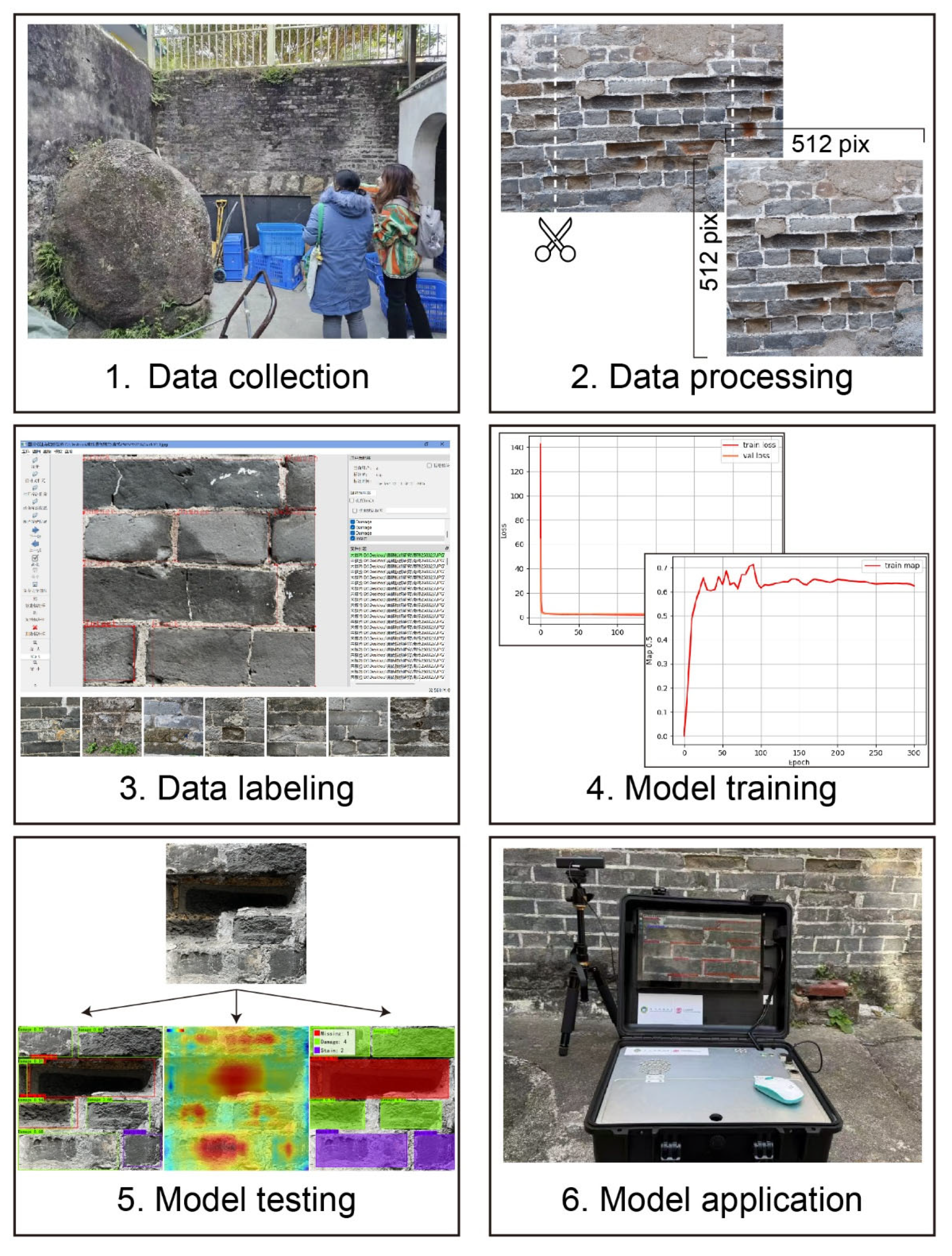
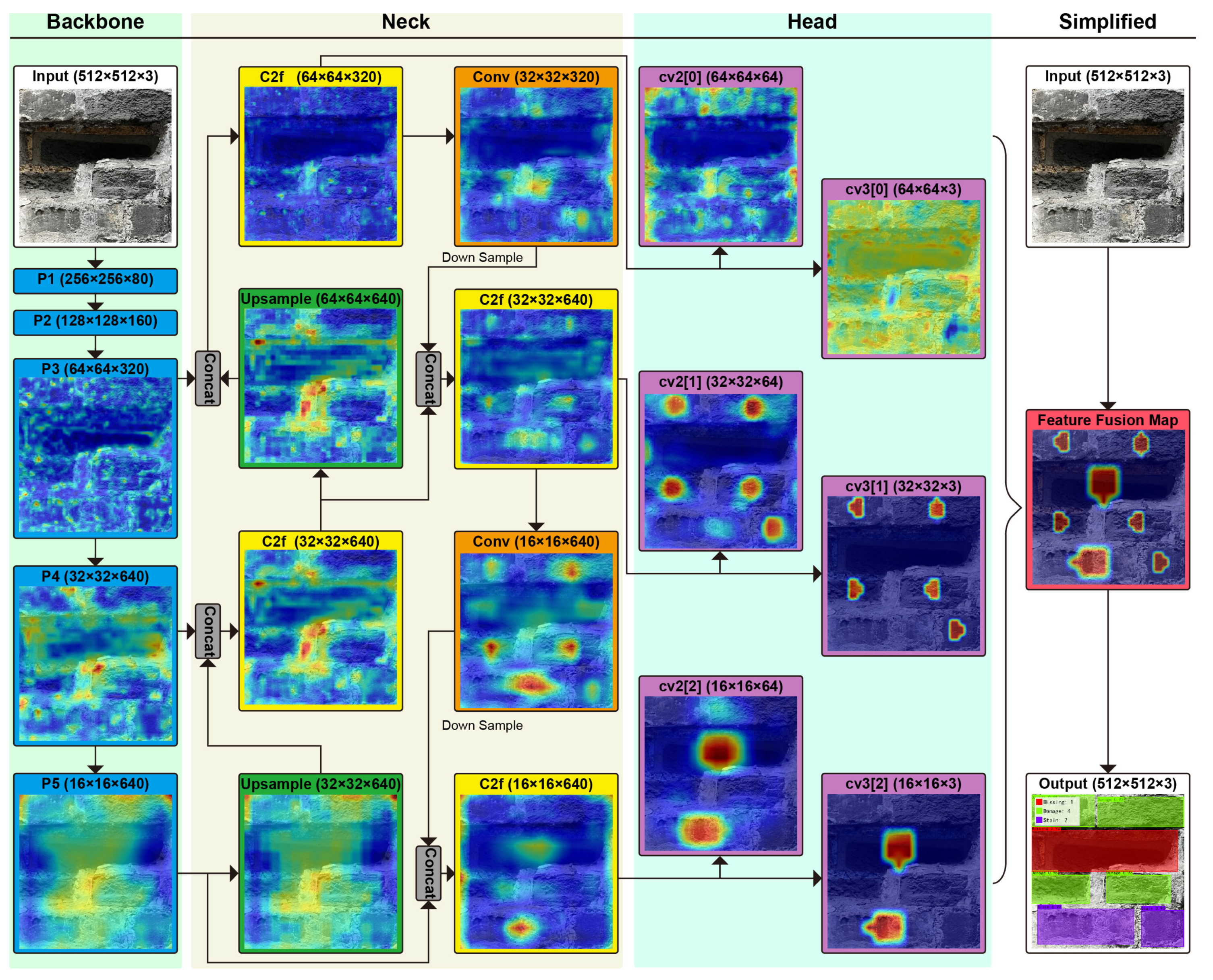
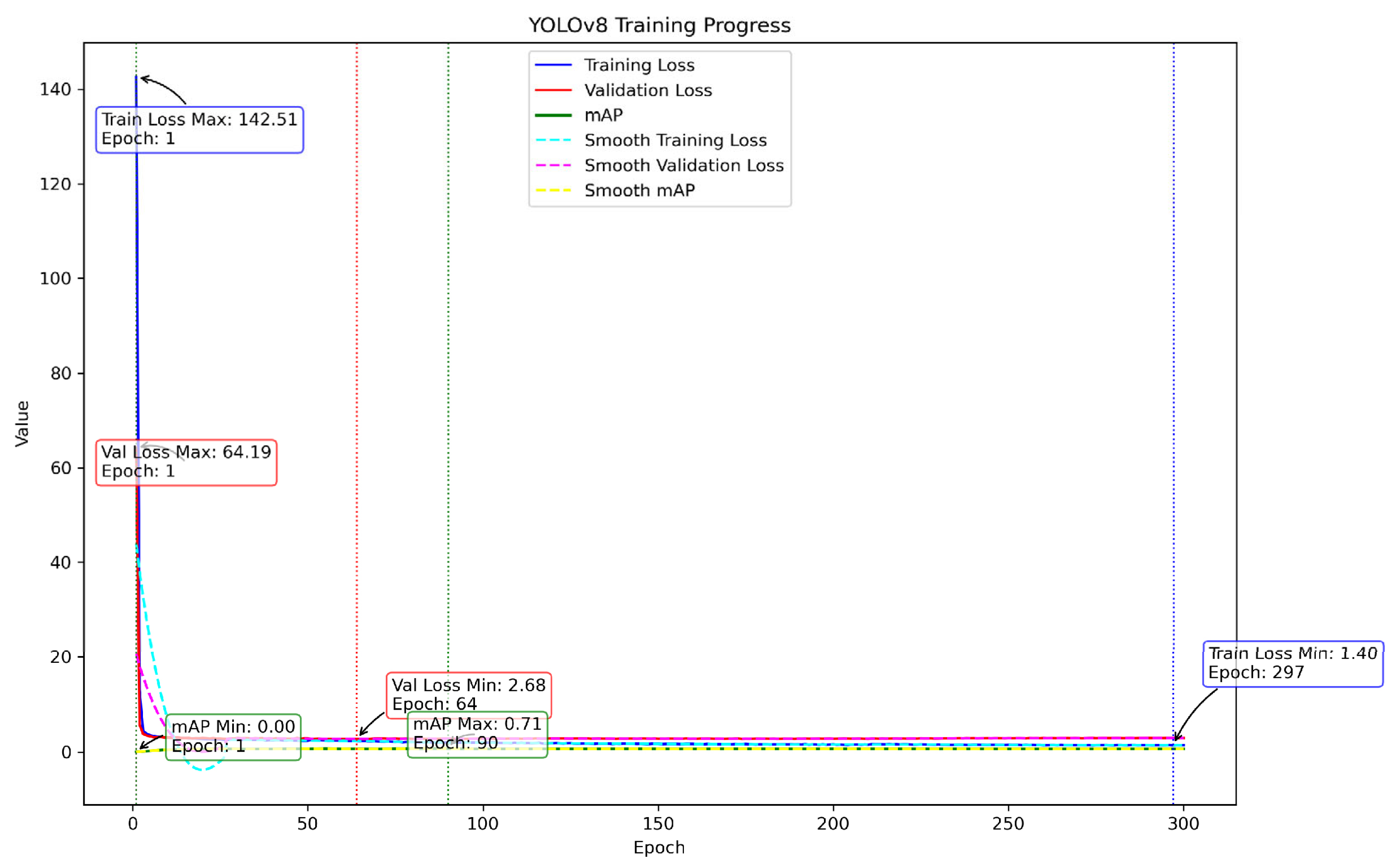
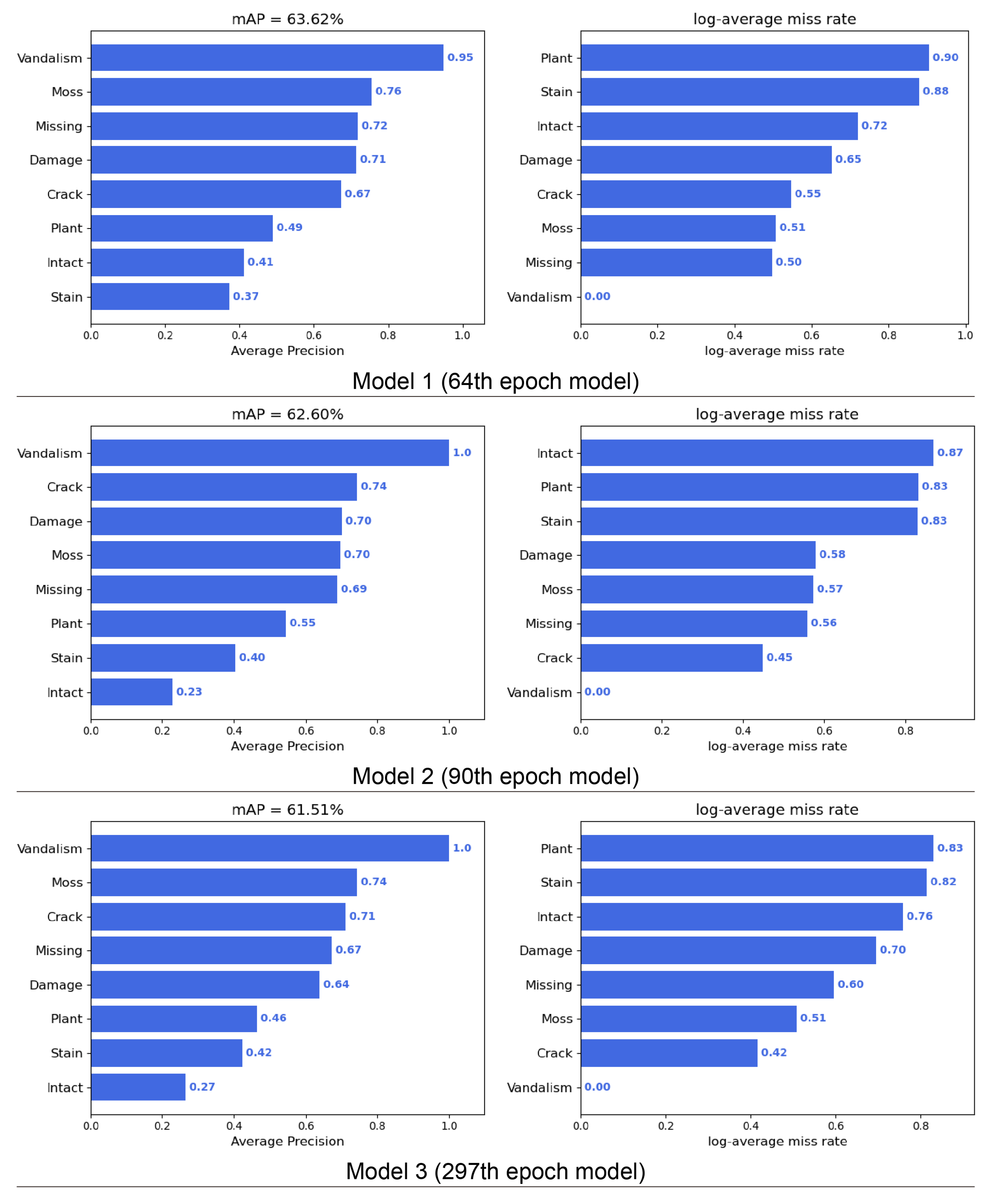
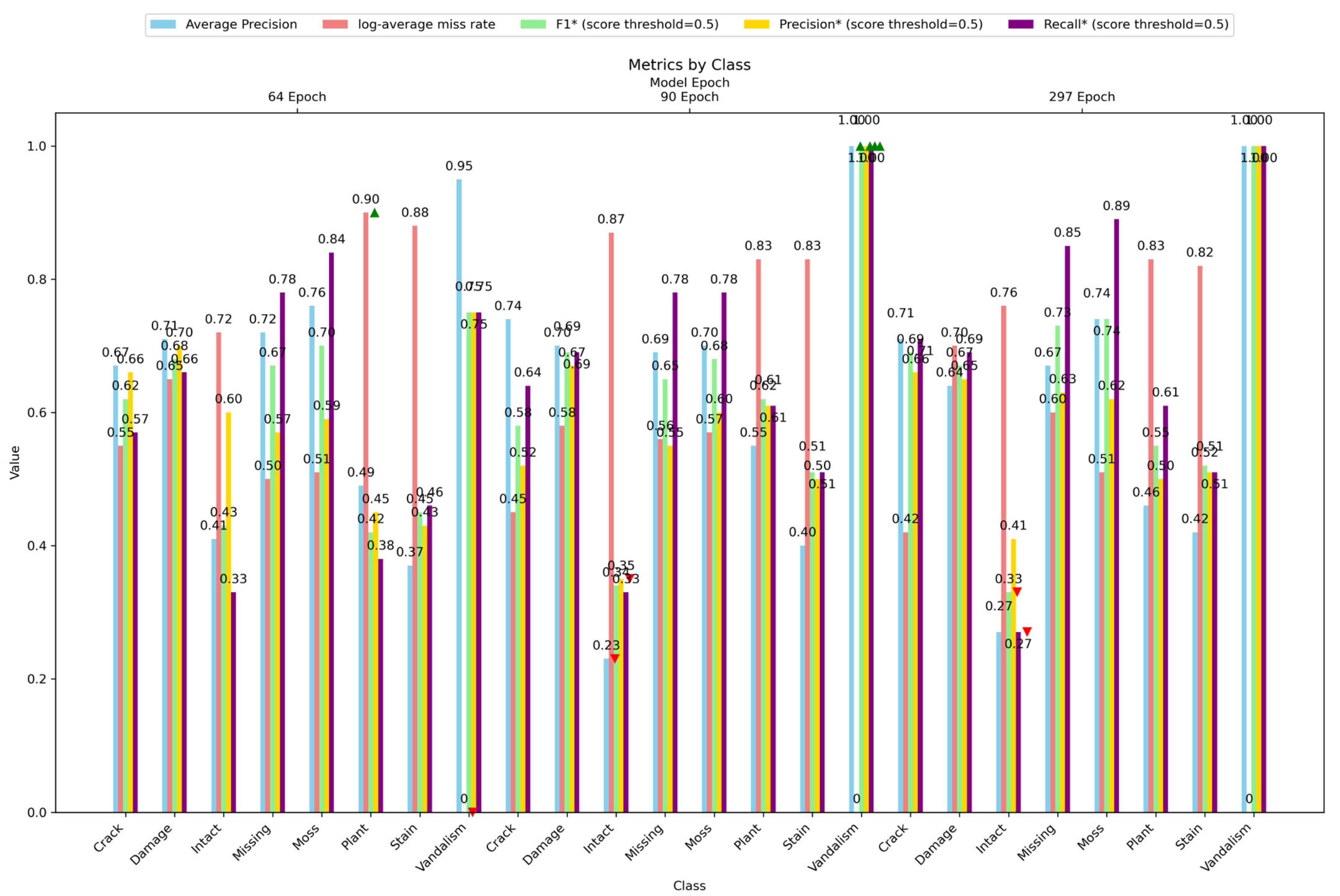
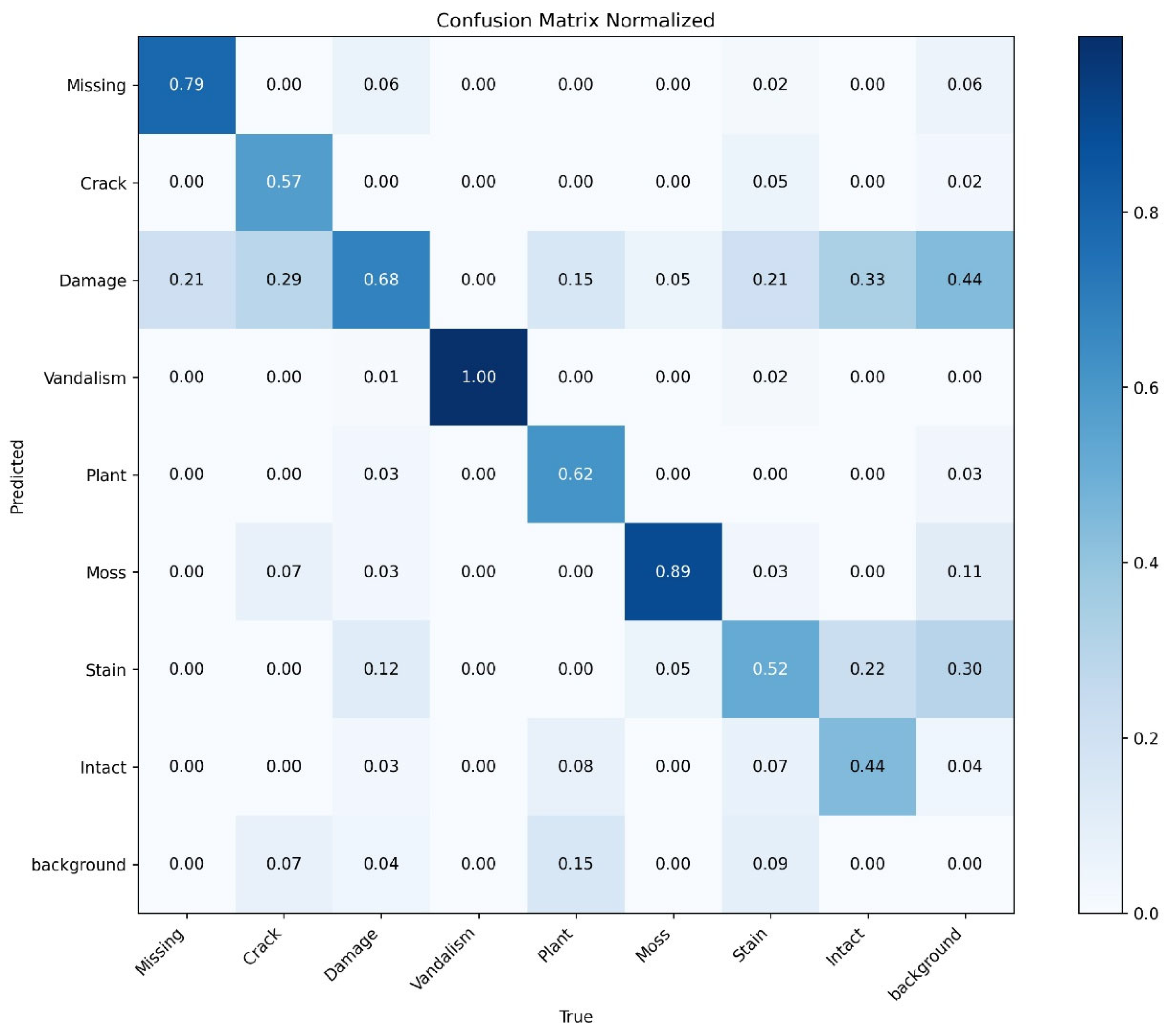
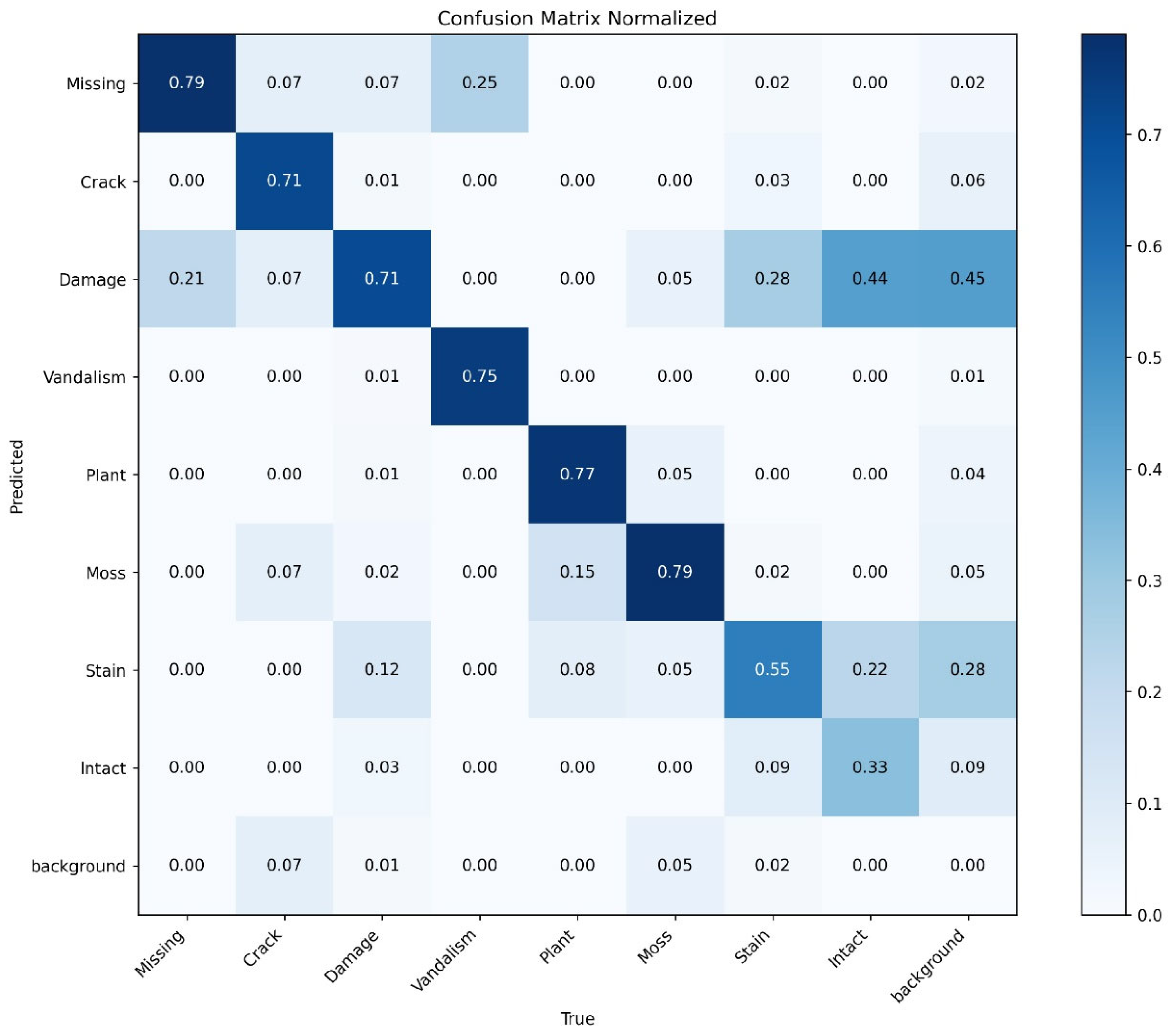
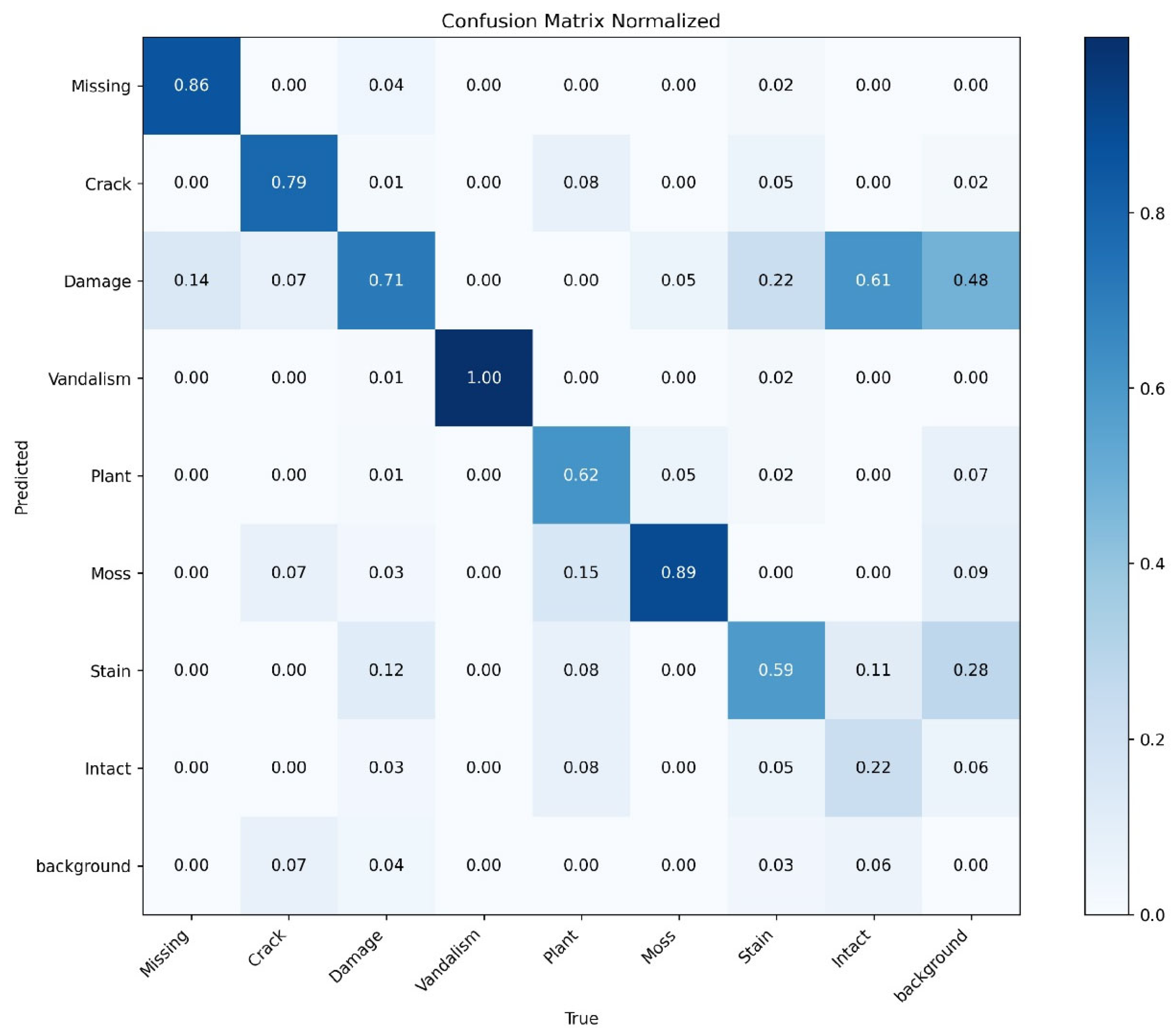

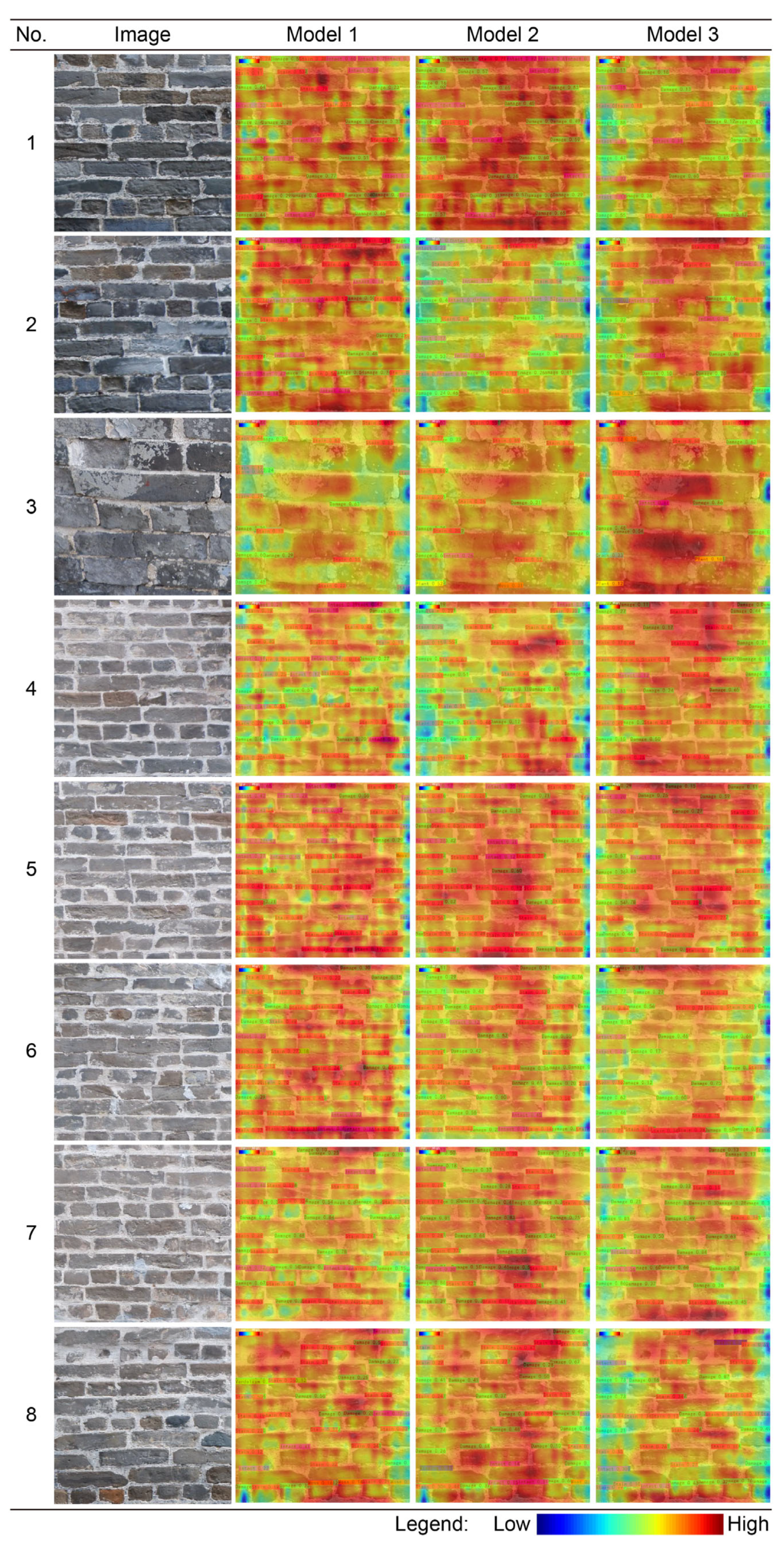
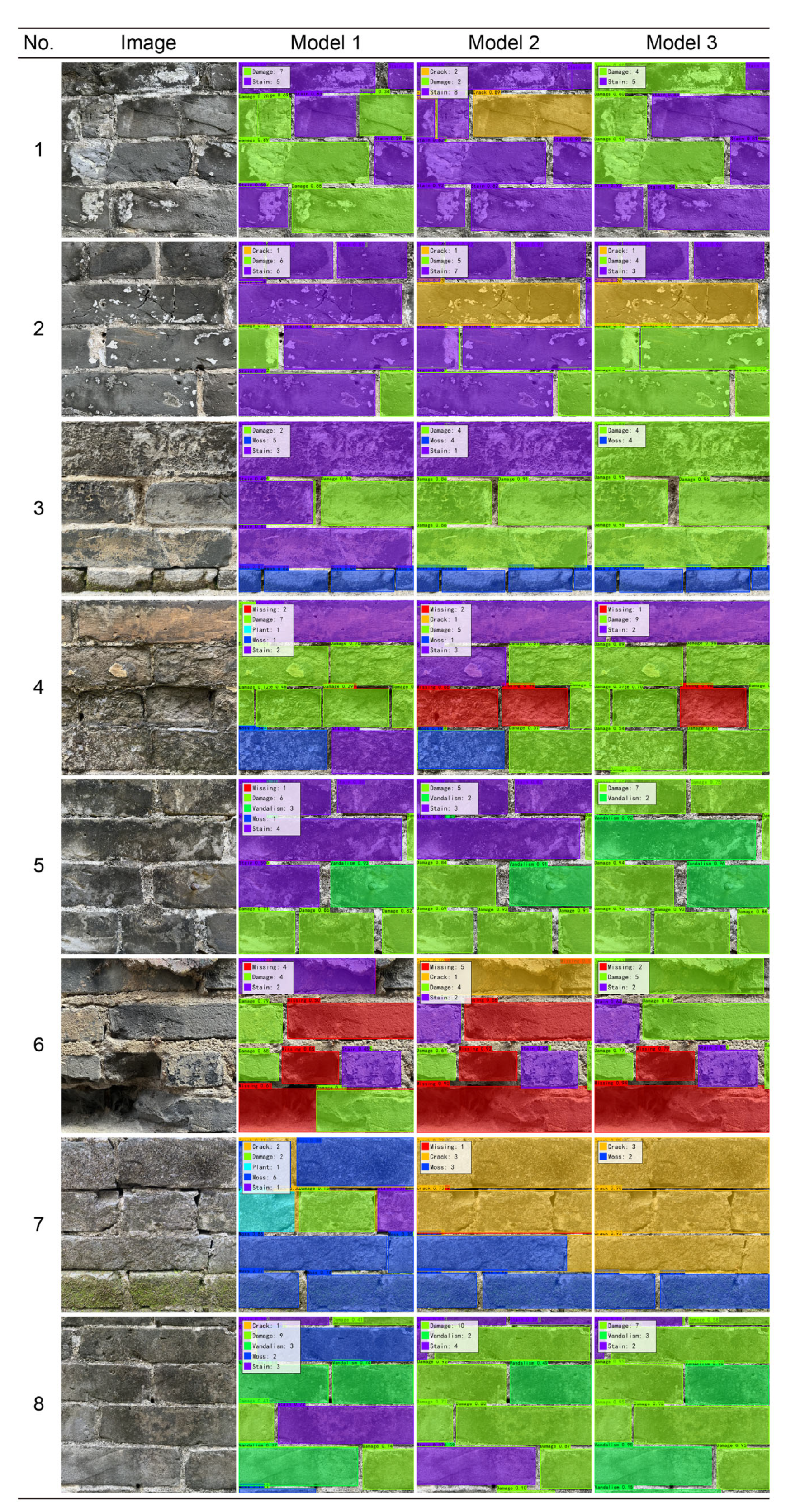
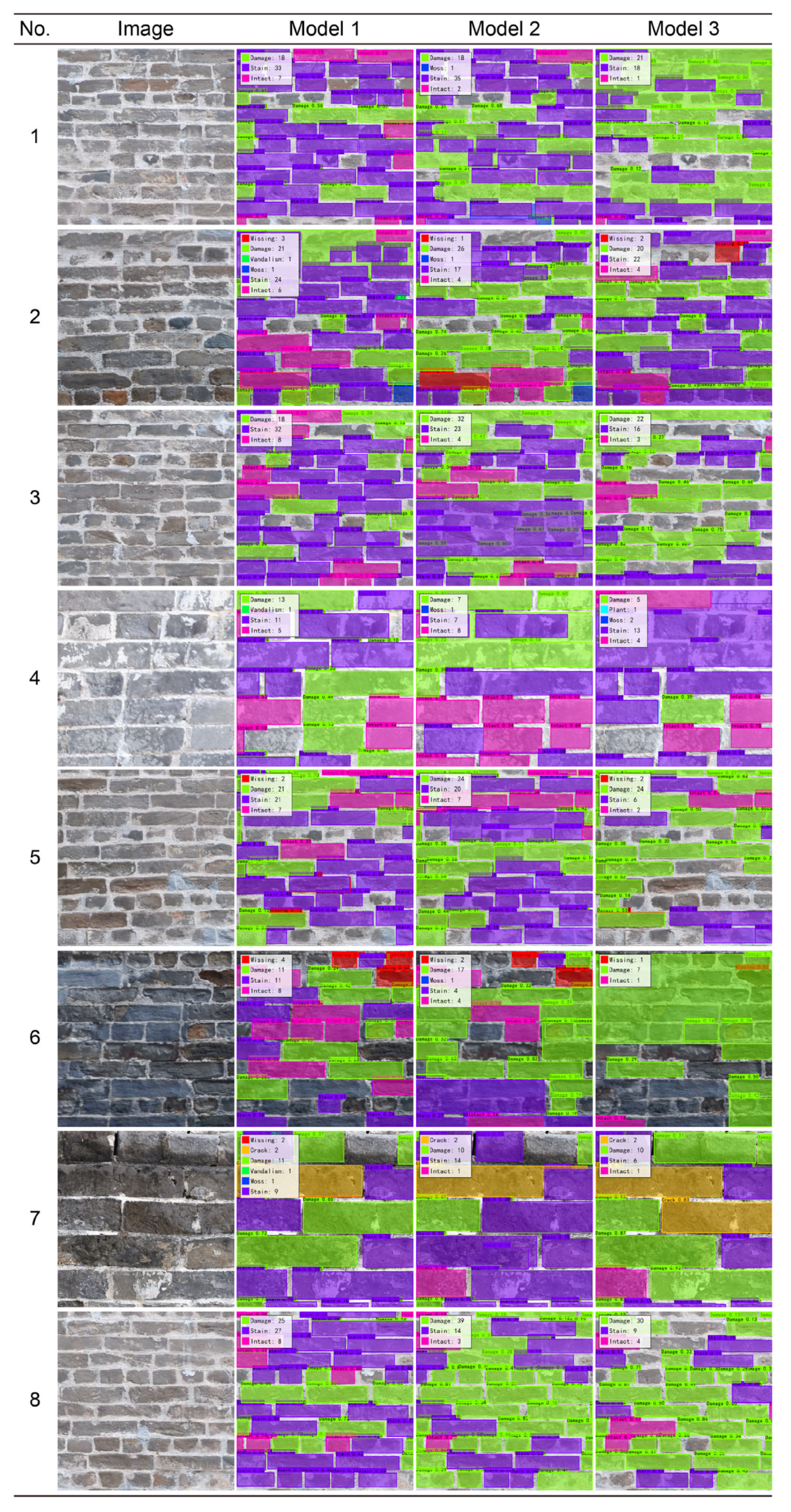
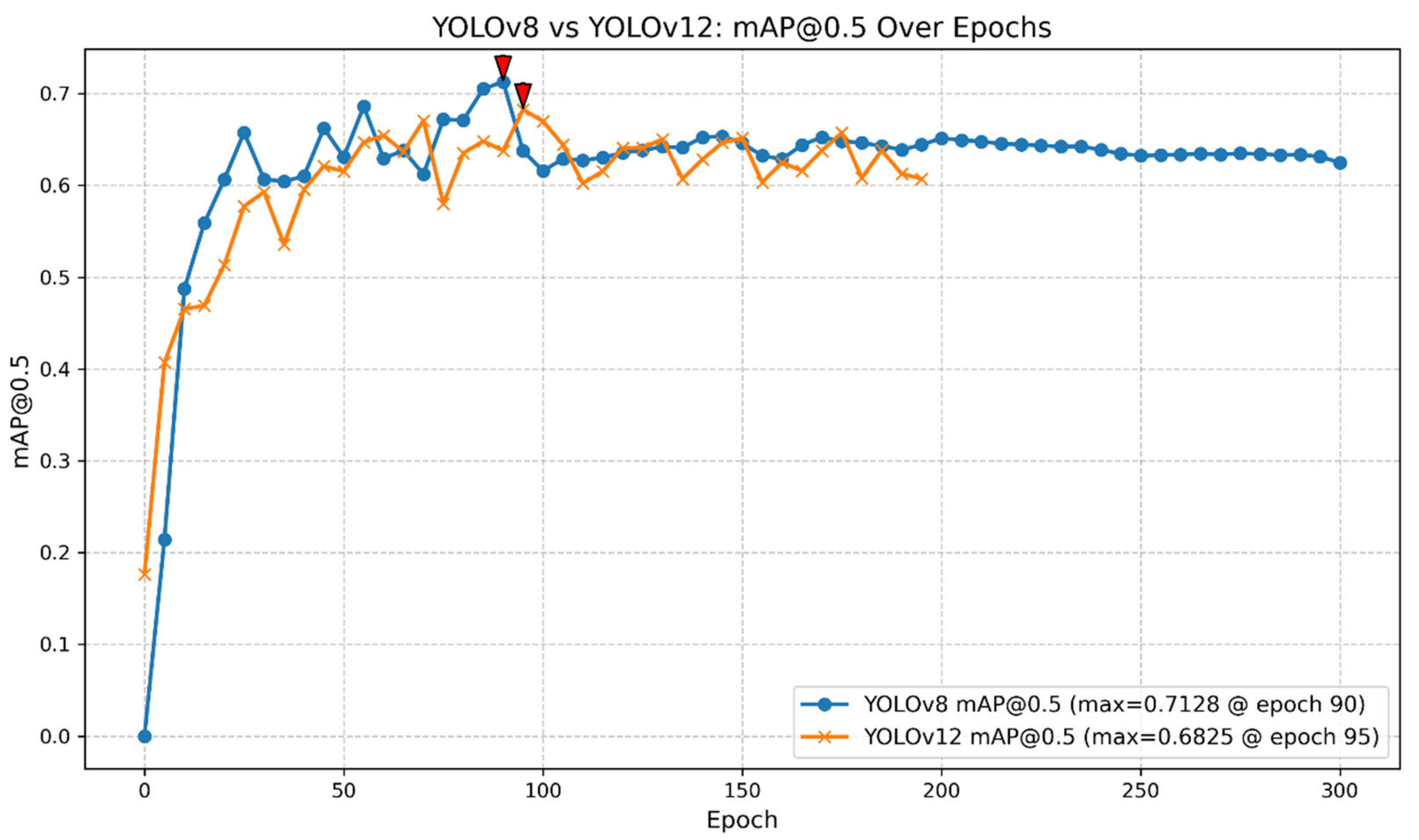
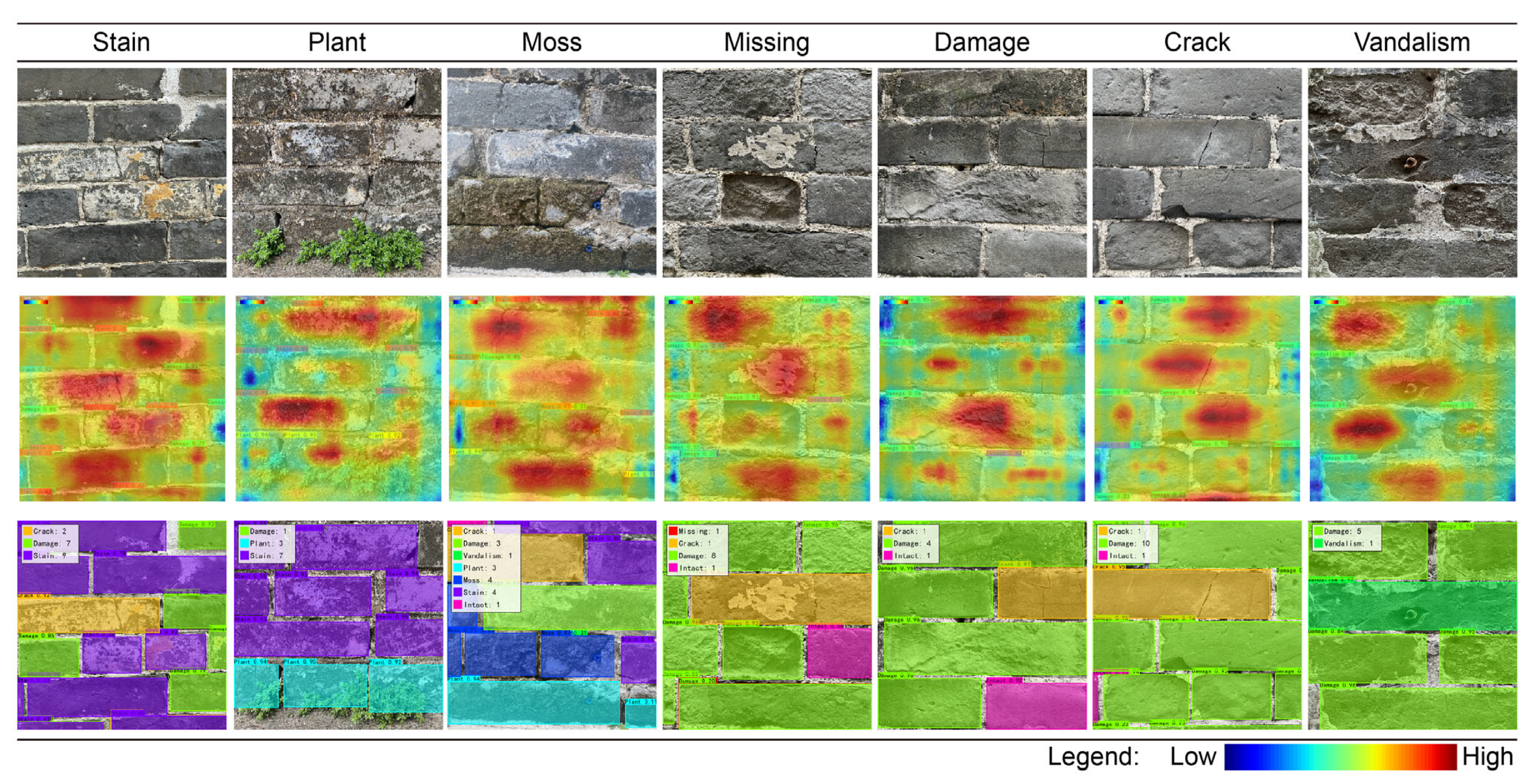
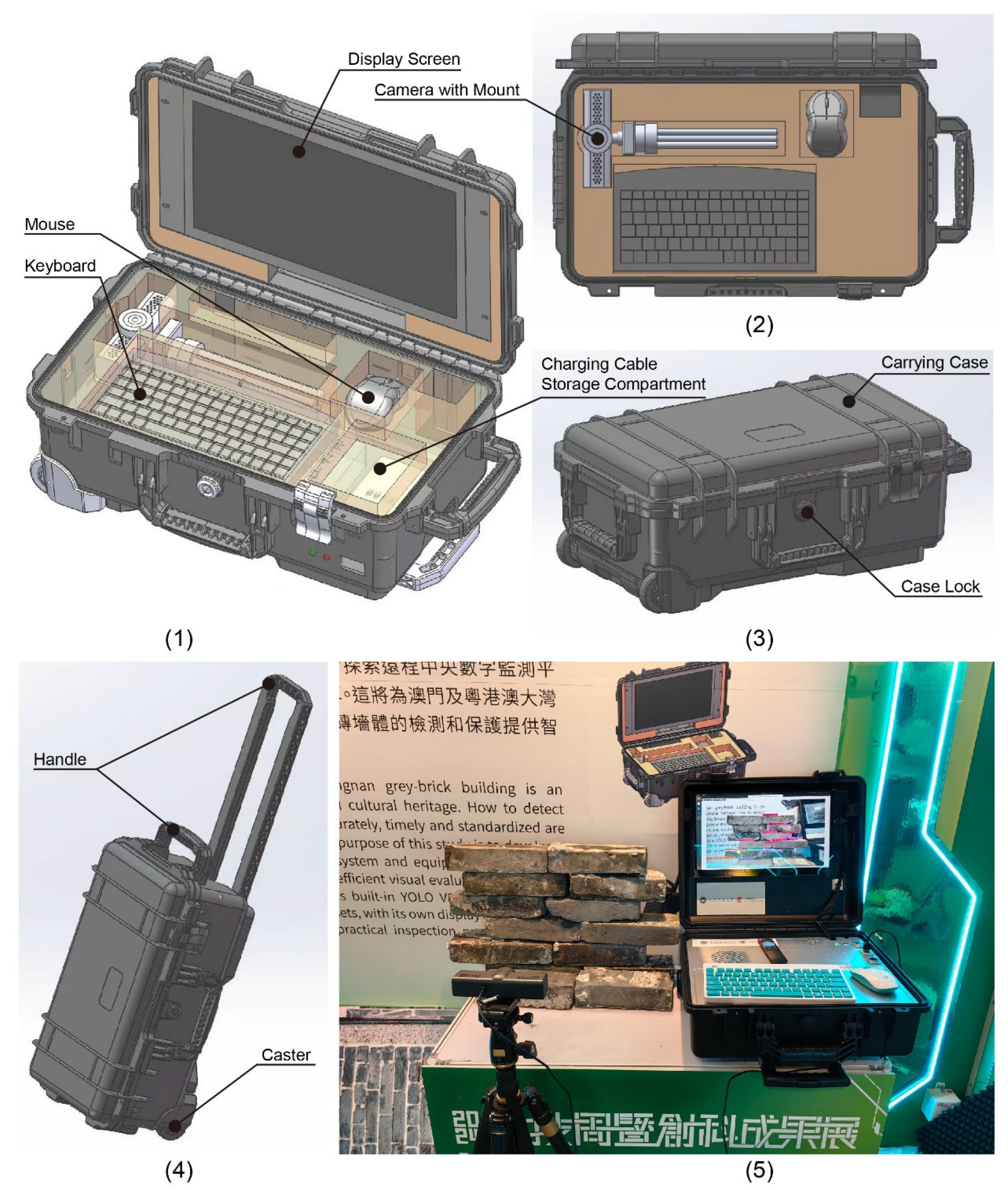
| Traditional Building Materials | Year | Case and Location | Analytical Techniques | Surface Damage Types or Characteristics |
|---|---|---|---|---|
| Chinese Gray-Brick | 2024 | White Temple Tower in Lanzhou City | Experiment on visual degradation characteristics during aging | Brick carvings and bricks in four different solutions were analyzed for compressive strength, surface hardness, mass, elastic wave velocity, and color differences [17]. |
| 2024 | Badaling section of the Great Wall | Improved-YOLOv5n object detection network | Four types are identified: bricks missing, weathering, plant growth, and cracks [18]. | |
| 2024 | Fuzhou’s Ancient Houses (Gu-Cuo) | YOLOv8 in computer vision | Identify two types of damage: efflorescence and plant growth [19]. | |
| 2023 | Macau World Heritage Buffer Zone | YOLOv4 in computer vision | Identifies five types of damage: missing, cracking, plant or microbial erosion, yellowing, and pollution on the exterior walls of ancient gray brick buildings [5]. | |
| 2023 | Plain Great Wall of Shanhaiguan | It automatically detects four types of damage (chalking, plants, ubiquinol, and cracking) on the surface [20]. | ||
| 2019 | Palace Museum Wall in Beijing City | Faster R-CNN based on ResNet101 | Detects two types of damage (efflorescence and spalling) [21]. | |
| 2018 | Forbidden City Wall in Beijing City | A sliding window-based CNN method | Identifies and locates four categories of damage (intact, crack, efflorescence, and spall) with an accuracy of 94.3% [22]. | |
| Shed-thin tile | 2024 | The Classical Gardens of Suzhou | YOLOv4 in computer vision | Identifies four types of damage: water staining, surface scaling, color aberration, and excessive gaps [23]. |
| Brick and stone surface | 2025 | White Pagoda in Lanzhou | The improved YOLOv8 | Identifies four types of damage: alkalinity, erode, spalling, and cracking [24]. |
| 2024 | Gulang Island in Xiamen City | Based on Swin Transformer and YOLOv5 | Identification of six types: plant penetration, moss, cracking, alkalization, staining, and deterioration [25]. | |
| 2019 | Anyuan Railway and Miners’ Club in Anyuan Town, Pingxiang City | Visual inspection and NDT methods | The physical and mechanical condition of the structural components is evaluated [26]. | |
| Gray roofing tile (clay terracotta tiles) from the Jiangnan region | 2025 | Longmen Ancient Town in Hangzhou City | YOLOv8 in computer vision | Identifies four types of tiles: green vegetation, dry vegetation, missing tiles, and repaired tiles [27]. |
| Sintered red clay tiles on sloping roofs | 2024 | Ancient villages in Quanzhou, Xiamen, and Zhangzhou | YOLOv8-seg model | Four large-scale roof damage types, namely collapse, deficiency, plant, and addition, are identified [28]. |
| Wooden structure | 2024 | Fujian Earthen Houses (Tulou) | YOLOv8 in computer vision | Identifies three types of damage: holes, stains, and cracks [29]. |
| 2023 | Dry column-type Miaoju building | An intelligent monitoring system using surface-bonded piezoelectric transducers (including actuators and sensors) with the structure | Identifies damage in different mortise–tenon joints [30] | |
| Chinese Clay Tiles | 2023 | Mandarin’s House in Macau | YOLOv4 in computer vision | Identifies three types: cracks, stains, and surface wear [31]. |
| Glazed tiles on the roof | 2019 | Forbidden City in Beijing City | Faster R-CNN | Identifies the damage to the two components, Goutou and Dishui, and counts the number [32]. |
| Traditional Building Materials | Year | Case and Location | Analytical Techniques | Equipment Development Results |
|---|---|---|---|---|
| Chinese Gray-Brick | 2019 | Palace Museum Wall in Beijing City | Faster R-CNN based on ResNet101 | Two new mobile object detection devices based on IP network cameras and smartphones [21]. |
| 2019 | Great Wall | Mobile Crowd Sensing (MCS) Technology | The GreatWatcher system was developed based on MCS technology and deep learning algorithms. The system components include a mobile client (data collection), a web platform (data storage database), and a computing terminal (data analysis and automatic damage detection) [33]. |
| Keys | Values | Keys | Values |
|---|---|---|---|
| Input shape | 512, 512 | Unfreeze batch size | 2 |
| Init epoch | 0 | Freeze train | True |
| Freeze epoch | 50 | Init learning rate | 0.01 |
| Unfreeze epoch | 300 | Min learning rate | 0.0001 |
| Freeze batch size | 4 | Optimizer type | SGD (Stochastic Gradient Descent) |
| momentum | 0.937 | Learning rate decay type | Cosine annealing |
| Epoch | Class | Average Precision | Log-Average Miss Rate | F1 * | Precision * | Recall * |
|---|---|---|---|---|---|---|
| 64 | Crack | 0.67 | 0.55 | 0.62 | 0.66 | 0.57 |
| Damage | 0.71 | 0.65 | 0.68 | 0.7 | 0.66 | |
| Intact | 0.41 | 0.72 | 0.43 | 0.6 | 0.33 | |
| Missing | 0.72 | 0.5 | 0.67 | 0.57 | 0.78 | |
| Moss | 0.76 | 0.51 | 0.7 | 0.59 | 0.84 | |
| Plant | 0.49 | 0.9 | 0.42 | 0.45 | 0.38 | |
| Stain | 0.37 | 0.88 | 0.45 | 0.43 | 0.46 | |
| Vandalism | 0.95 | 0 | 0.75 | 0.75 | 0.75 | |
| 90 | Crack | 0.74 | 0.45 | 0.58 | 0.52 | 0.64 |
| Damage | 0.7 | 0.58 | 0.69 | 0.67 | 0.69 | |
| Intact | 0.23 | 0.87 | 0.34 | 0.35 | 0.33 | |
| Missing | 0.69 | 0.56 | 0.65 | 0.55 | 0.78 | |
| Moss | 0.7 | 0.57 | 0.68 | 0.6 | 0.78 | |
| Plant | 0.55 | 0.83 | 0.62 | 0.61 | 0.61 | |
| Stain | 0.4 | 0.83 | 0.51 | 0.5 | 0.51 | |
| Vandalism | 1 | 0 | 1 | 1 | 1 | |
| 297 | Crack | 0.71 | 0.42 | 0.69 | 0.66 | 0.71 |
| Damage | 0.64 | 0.7 | 0.67 | 0.65 | 0.69 | |
| Intact | 0.27 | 0.76 | 0.33 | 0.41 | 0.27 | |
| Missing | 0.67 | 0.6 | 0.73 | 0.63 | 0.85 | |
| Moss | 0.74 | 0.51 | 0.74 | 0.62 | 0.89 | |
| Plant | 0.46 | 0.83 | 0.55 | 0.5 | 0.61 | |
| Stain | 0.42 | 0.82 | 0.52 | 0.51 | 0.51 | |
| Vandalism | 1 | 0 | 1 | 1 | 1 |
Disclaimer/Publisher’s Note: The statements, opinions and data contained in all publications are solely those of the individual author(s) and contributor(s) and not of MDPI and/or the editor(s). MDPI and/or the editor(s) disclaim responsibility for any injury to people or property resulting from any ideas, methods, instructions or products referred to in the content. |
© 2025 by the authors. Licensee MDPI, Basel, Switzerland. This article is an open access article distributed under the terms and conditions of the Creative Commons Attribution (CC BY) license (https://creativecommons.org/licenses/by/4.0/).
Share and Cite
Zheng, L.; Zheng, J.; Chen, Y.; Zheng, Y.; Lao, W.; Chen, S. Gray Brick Wall Surface Damage Detection of Traditional Chinese Buildings in Macau: Damage Quantification and Thermodynamic Analysis Method via YOLOv8 Technology. Appl. Sci. 2025, 15, 6665. https://doi.org/10.3390/app15126665
Zheng L, Zheng J, Chen Y, Zheng Y, Lao W, Chen S. Gray Brick Wall Surface Damage Detection of Traditional Chinese Buildings in Macau: Damage Quantification and Thermodynamic Analysis Method via YOLOv8 Technology. Applied Sciences. 2025; 15(12):6665. https://doi.org/10.3390/app15126665
Chicago/Turabian StyleZheng, Liang, Jianyi Zheng, Yile Chen, Yuchan Zheng, Wei Lao, and Shuaipeng Chen. 2025. "Gray Brick Wall Surface Damage Detection of Traditional Chinese Buildings in Macau: Damage Quantification and Thermodynamic Analysis Method via YOLOv8 Technology" Applied Sciences 15, no. 12: 6665. https://doi.org/10.3390/app15126665
APA StyleZheng, L., Zheng, J., Chen, Y., Zheng, Y., Lao, W., & Chen, S. (2025). Gray Brick Wall Surface Damage Detection of Traditional Chinese Buildings in Macau: Damage Quantification and Thermodynamic Analysis Method via YOLOv8 Technology. Applied Sciences, 15(12), 6665. https://doi.org/10.3390/app15126665









